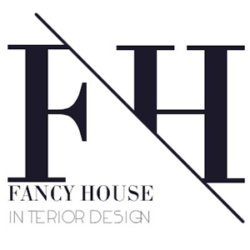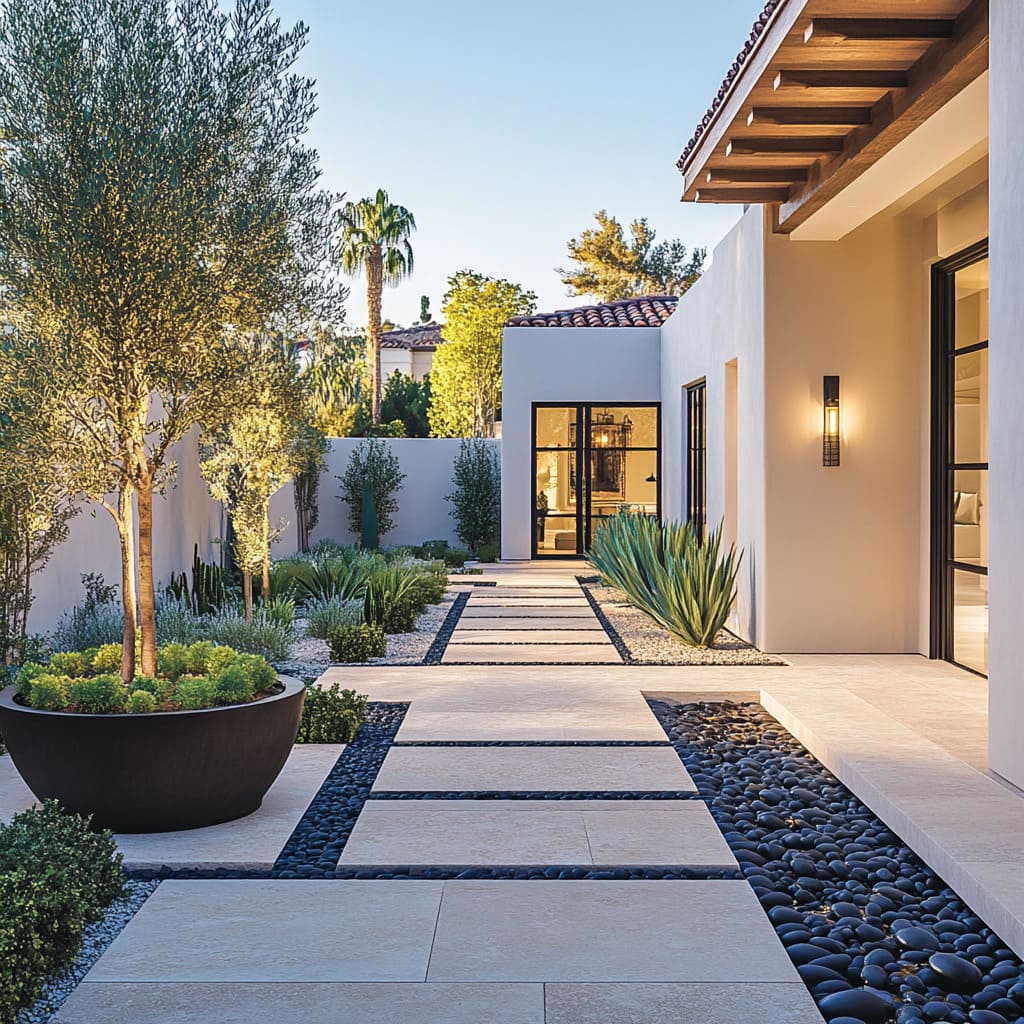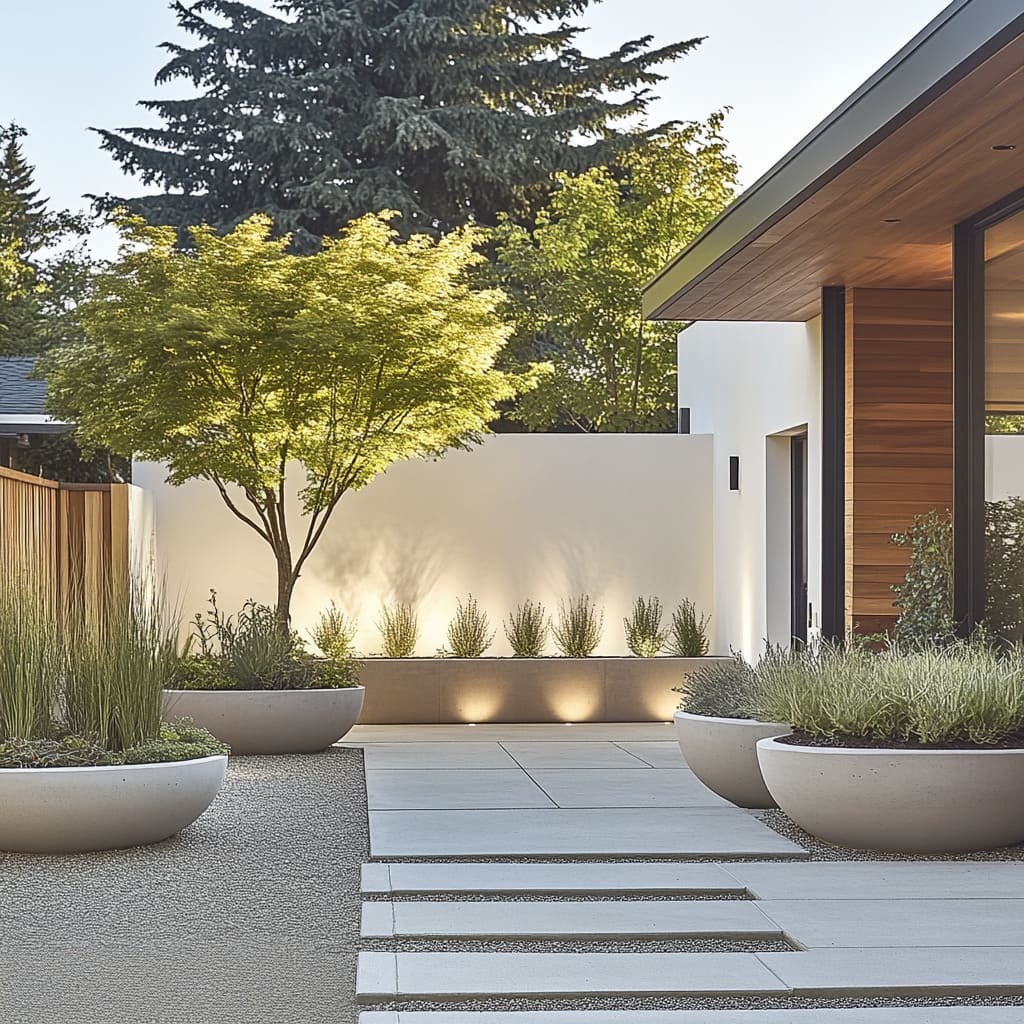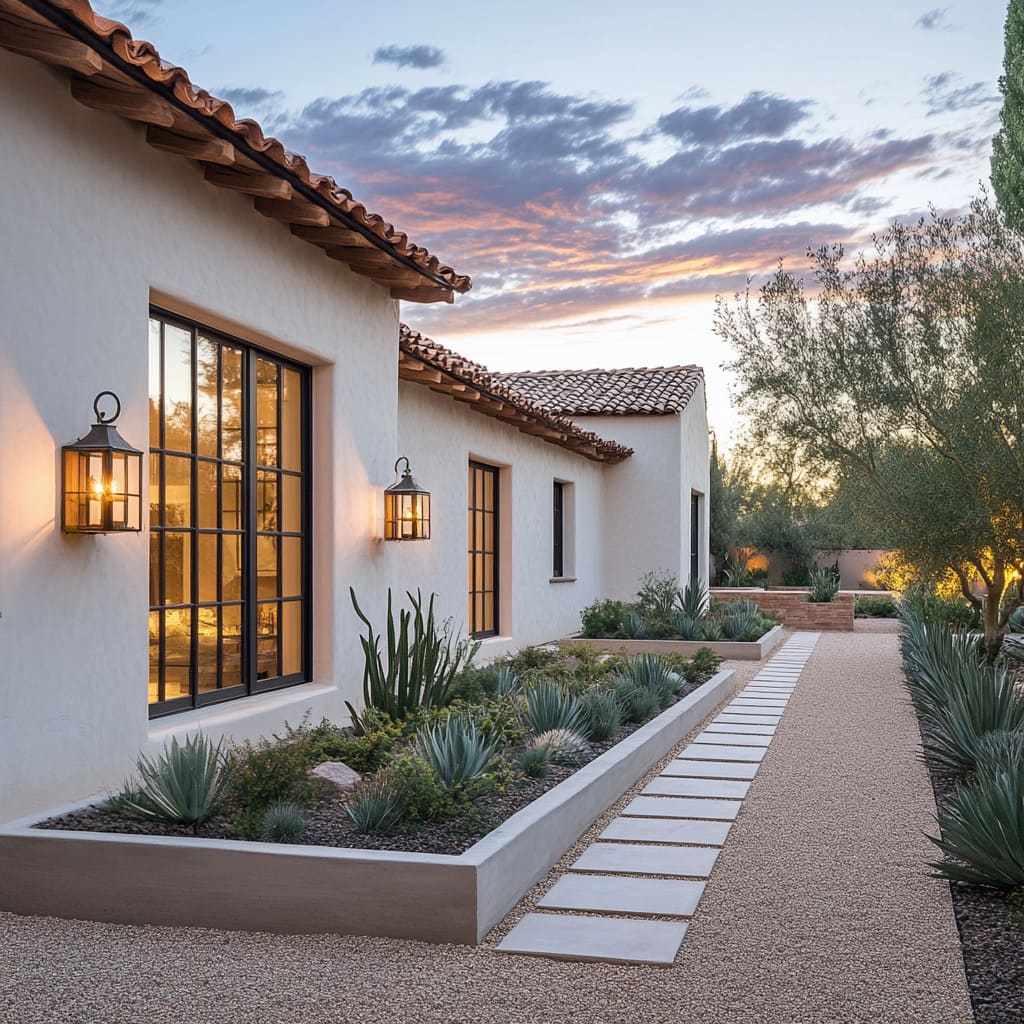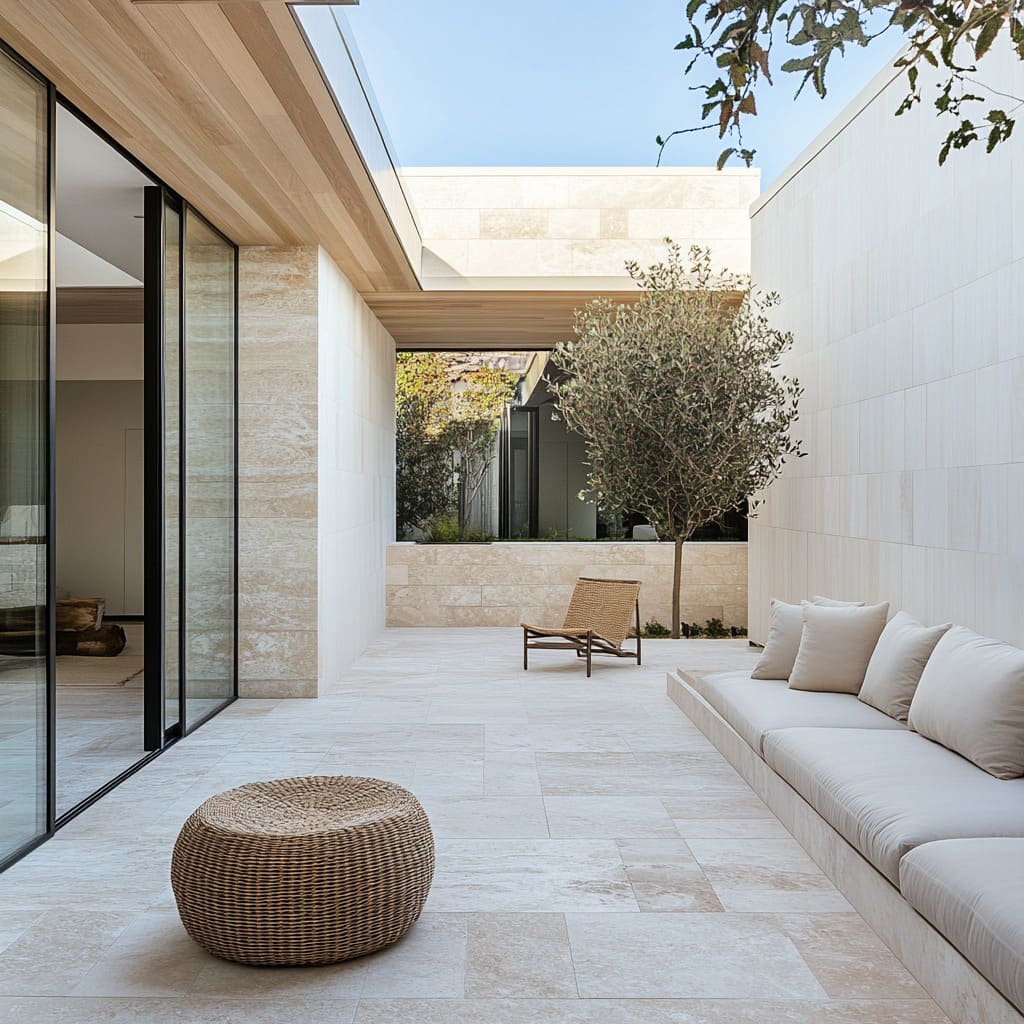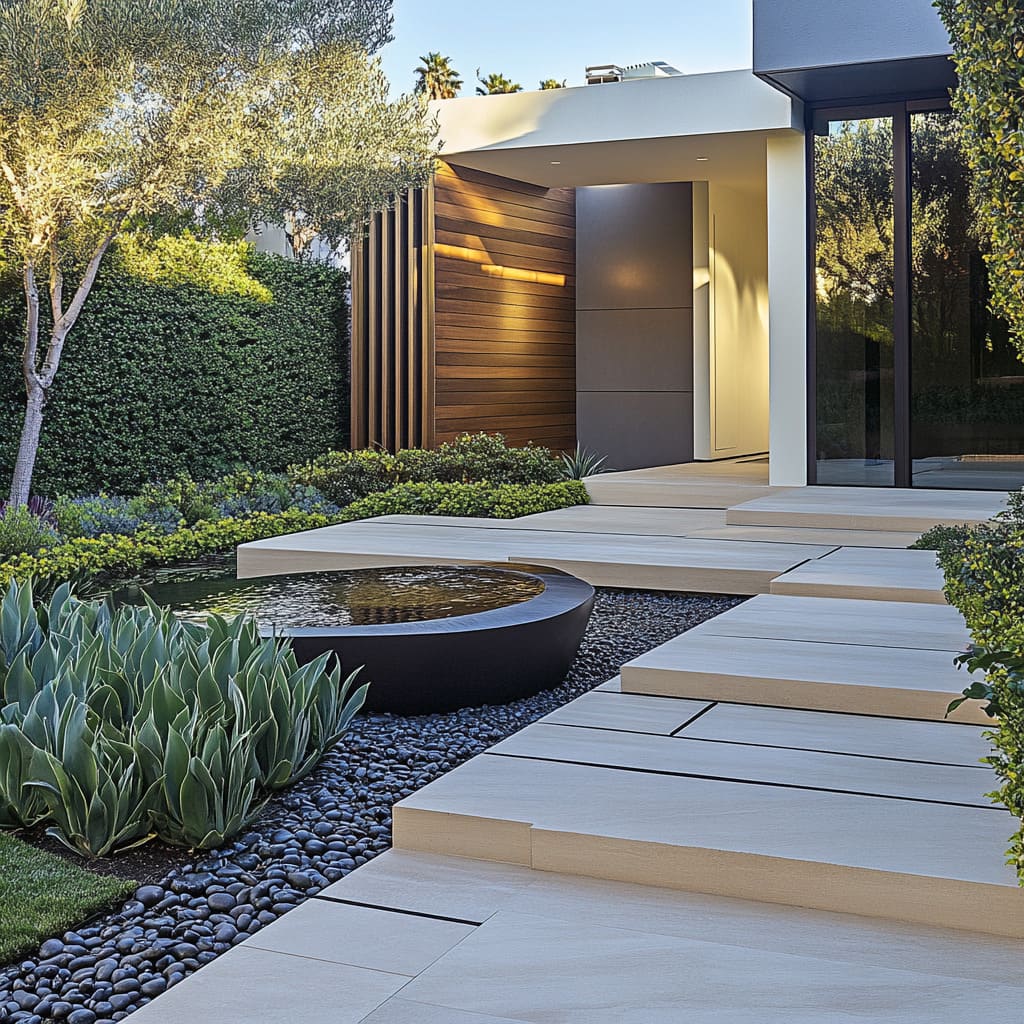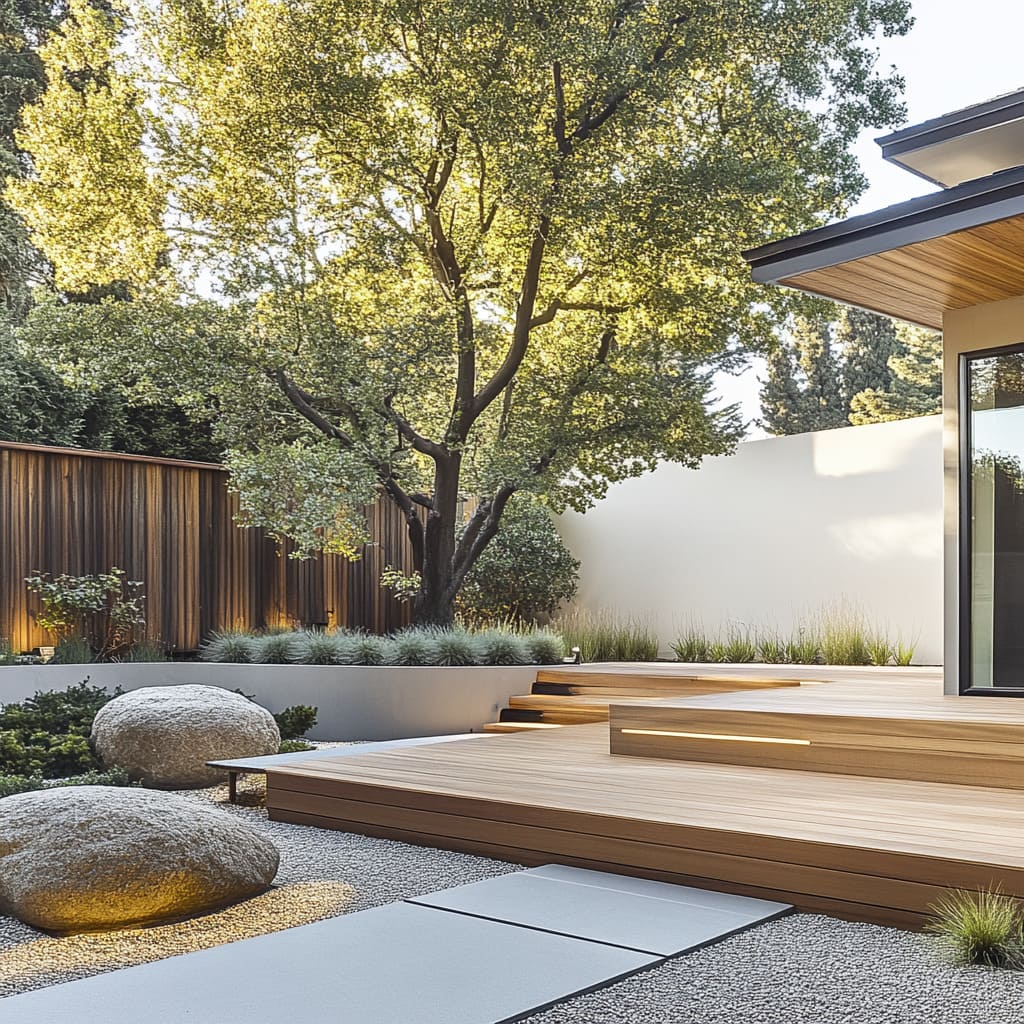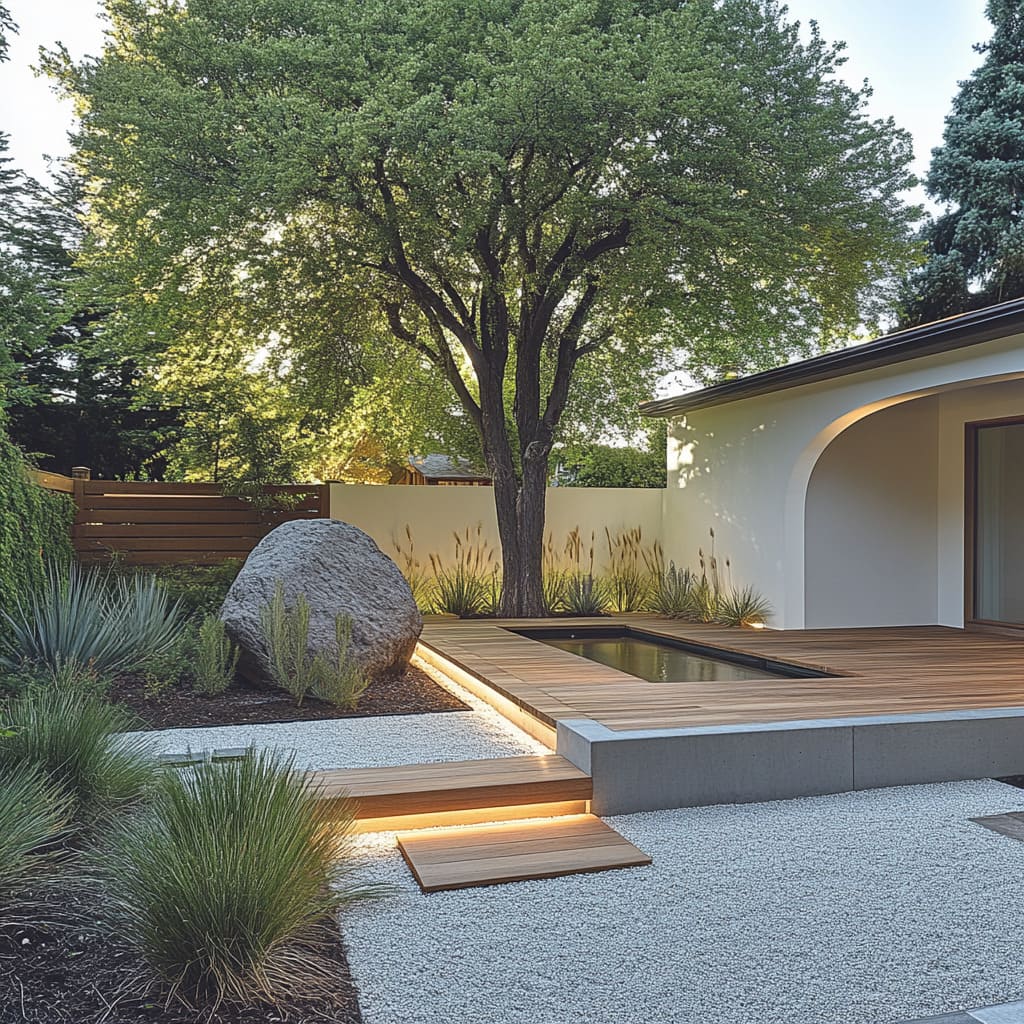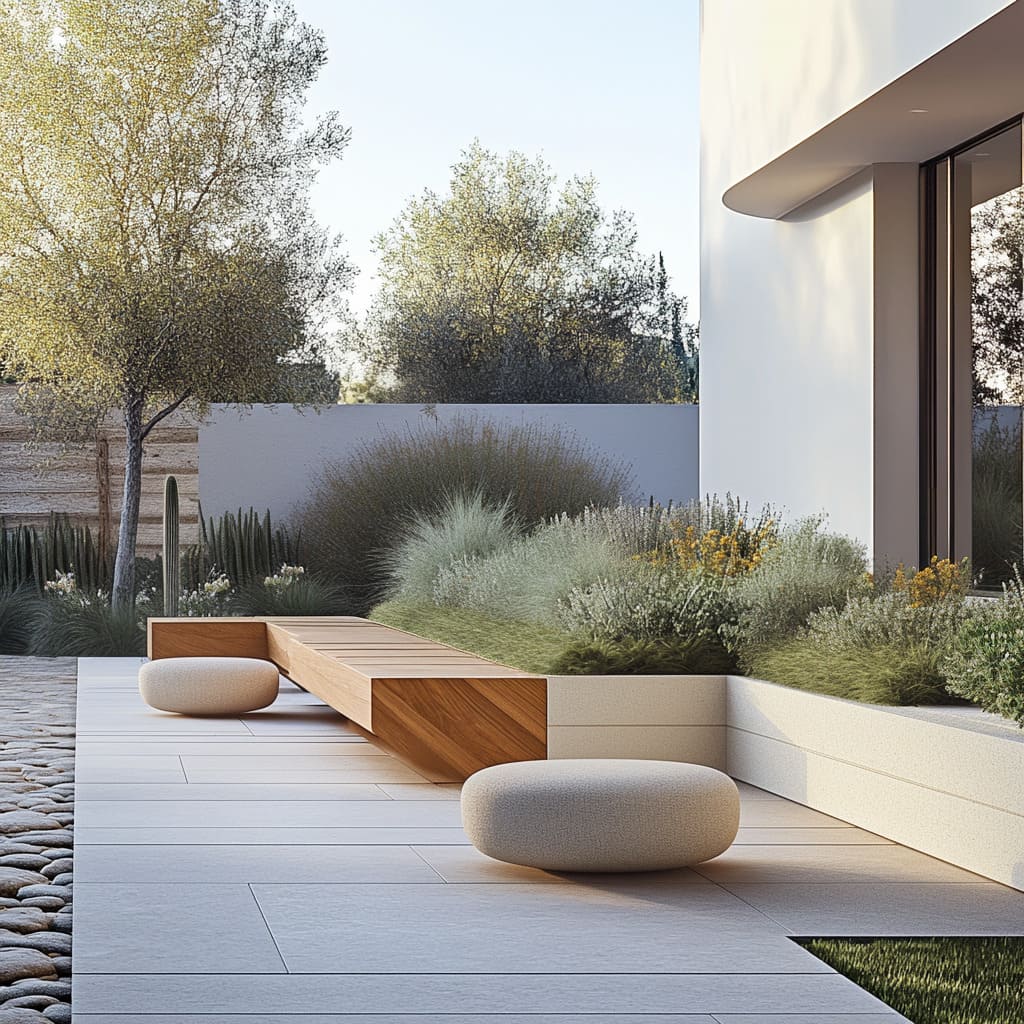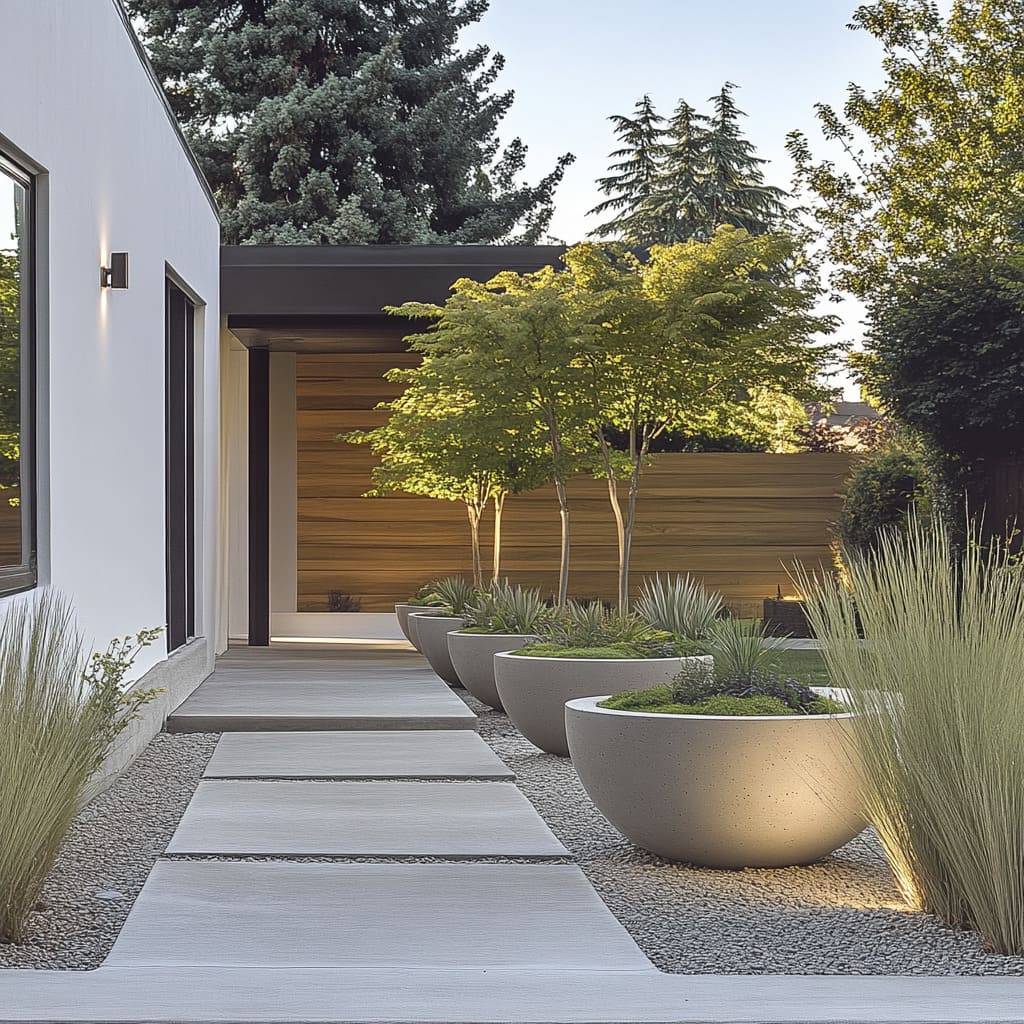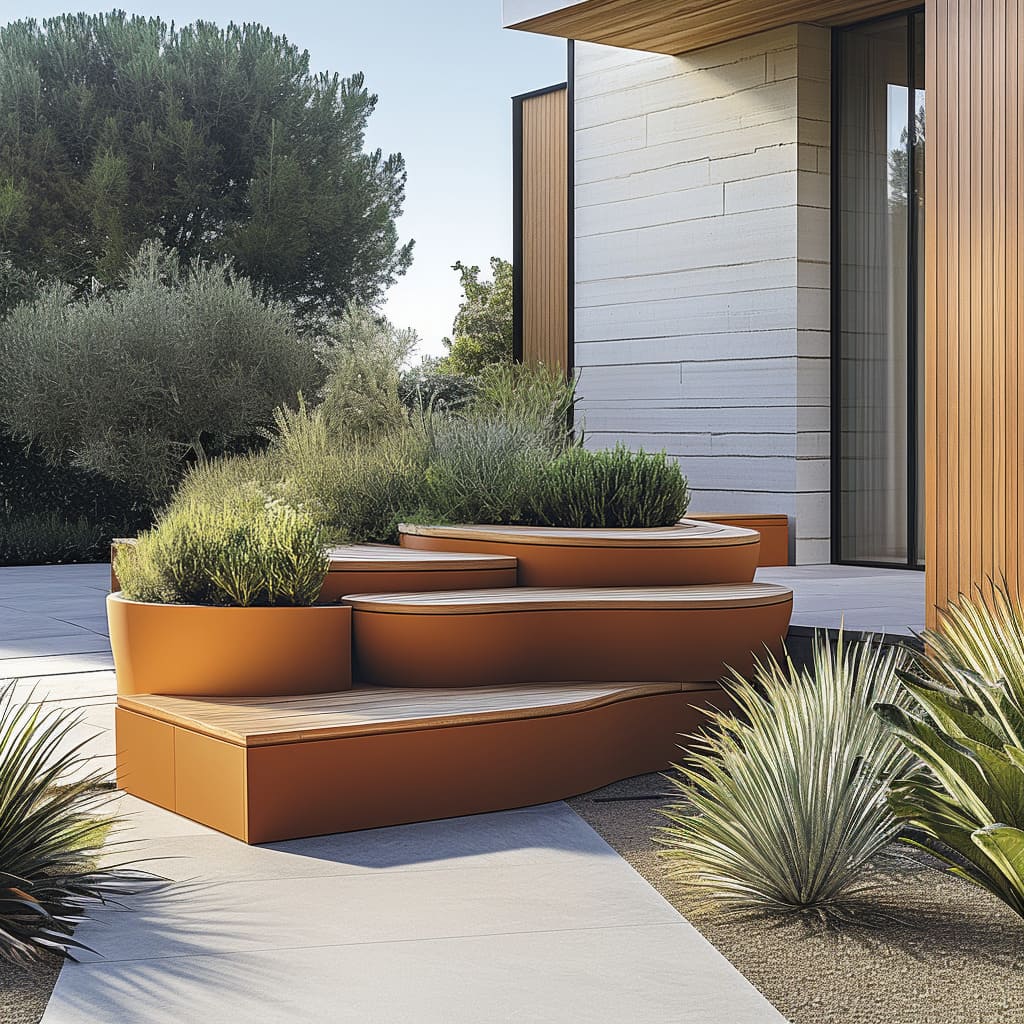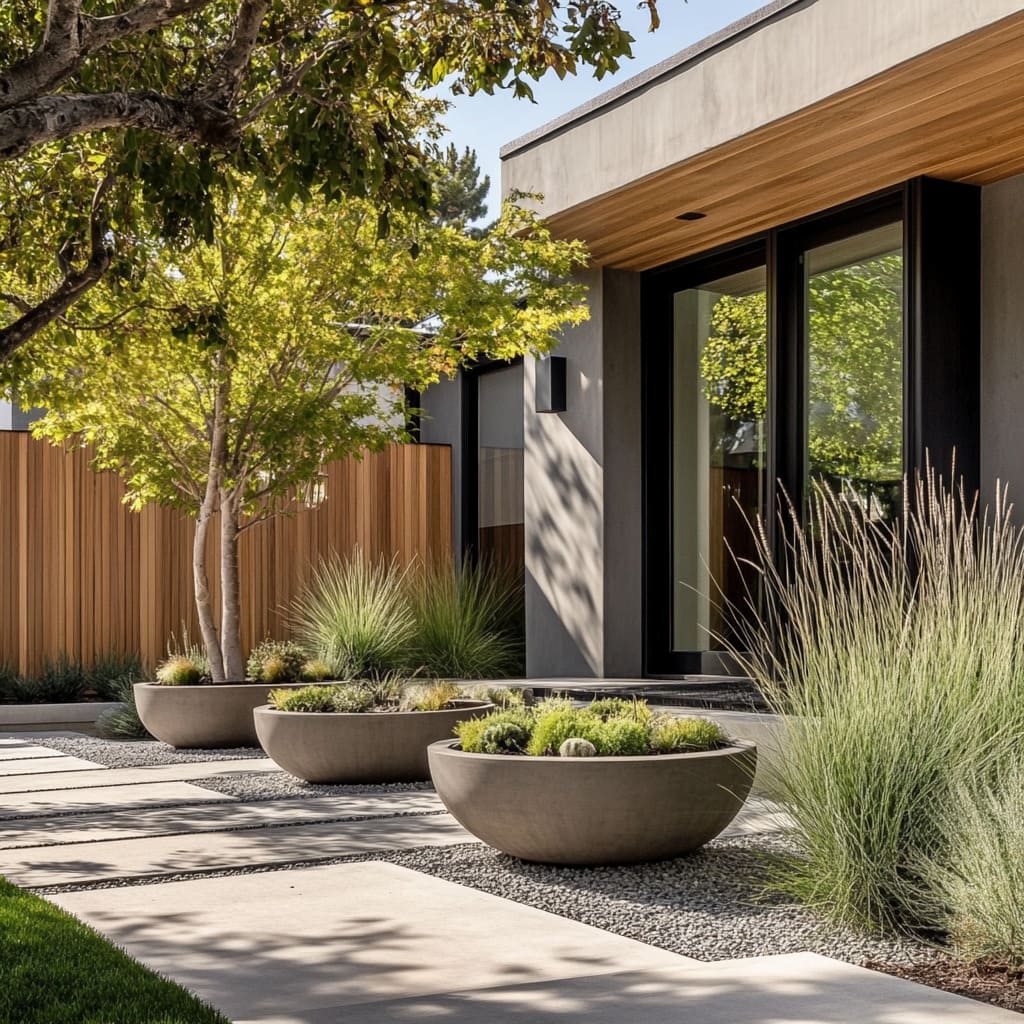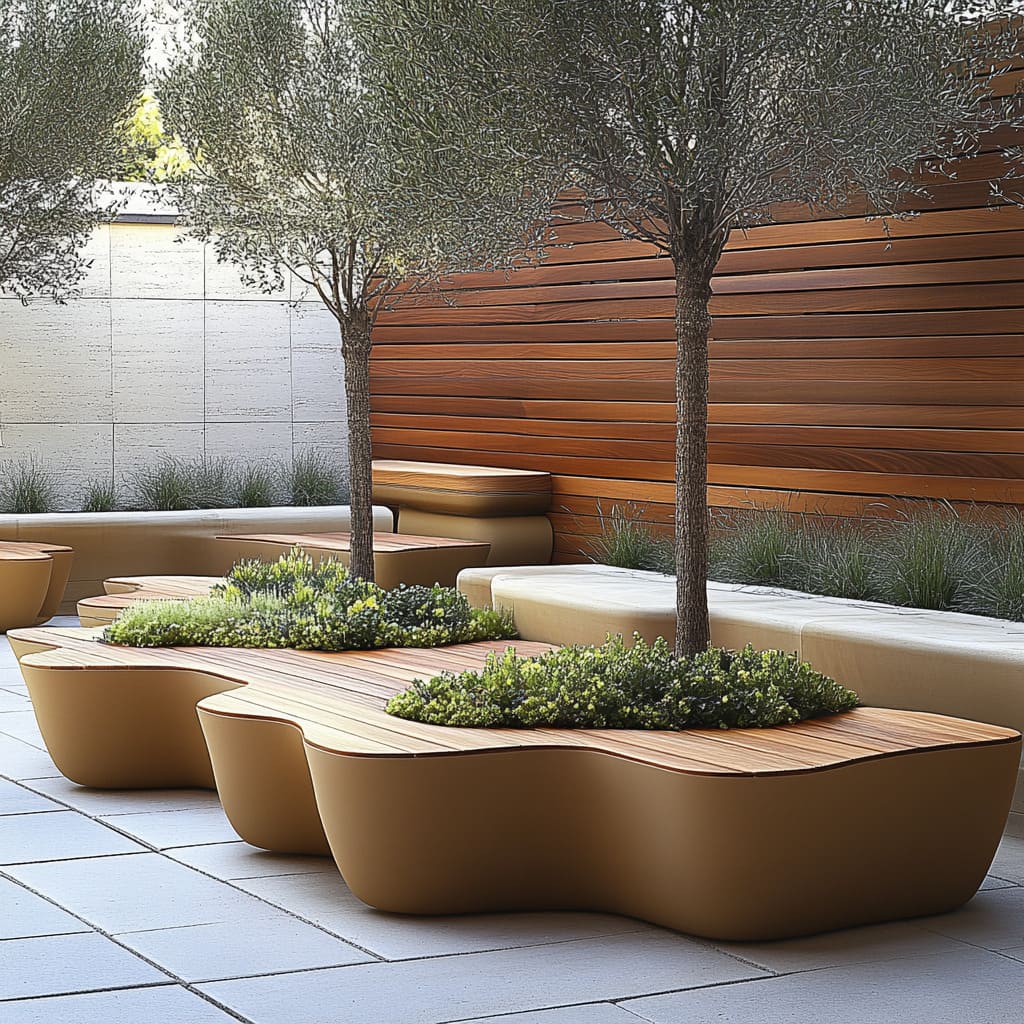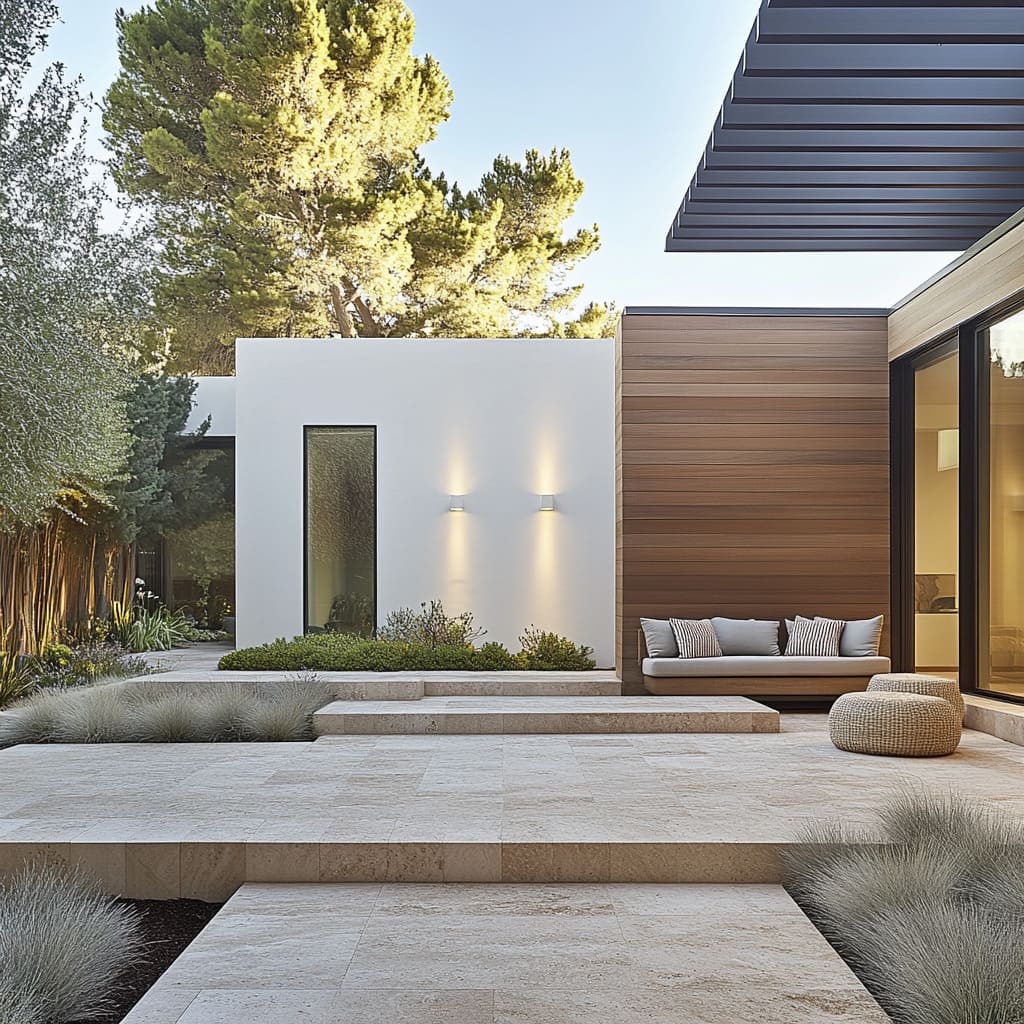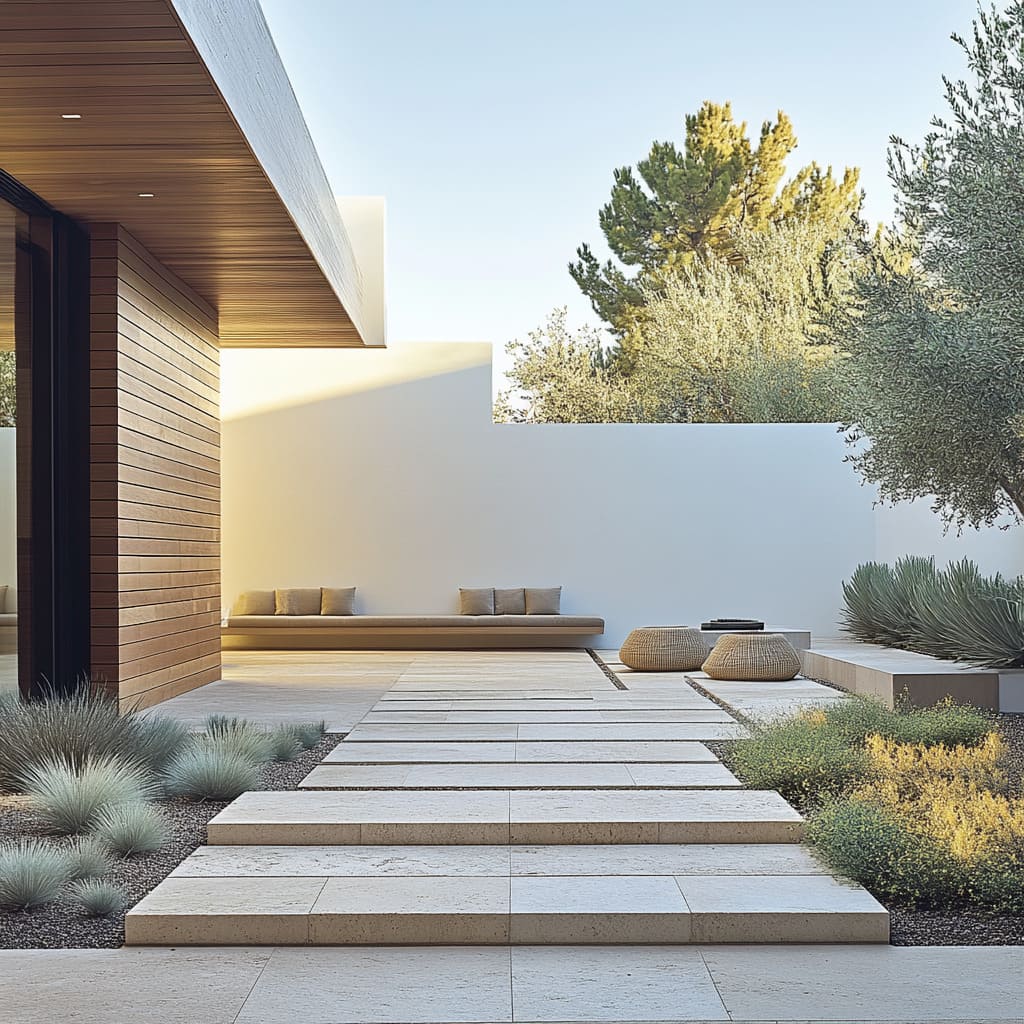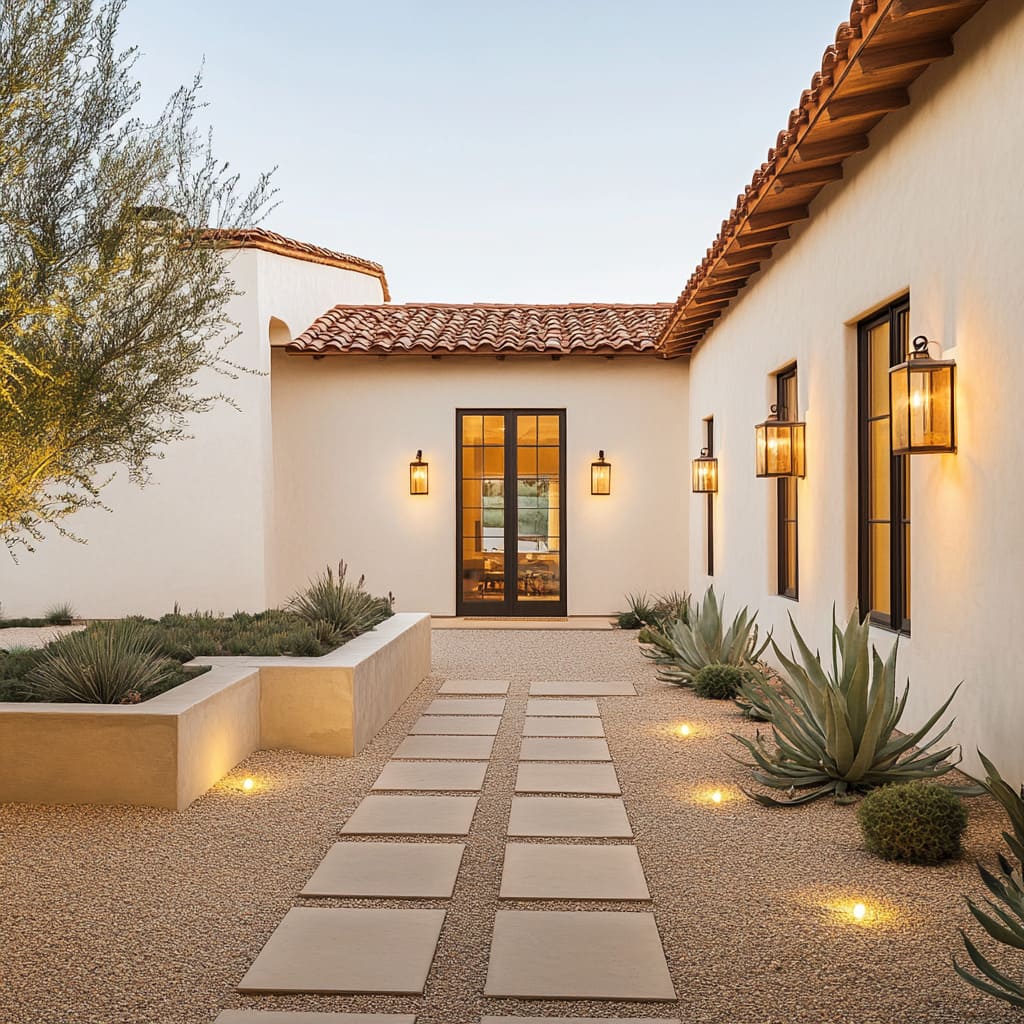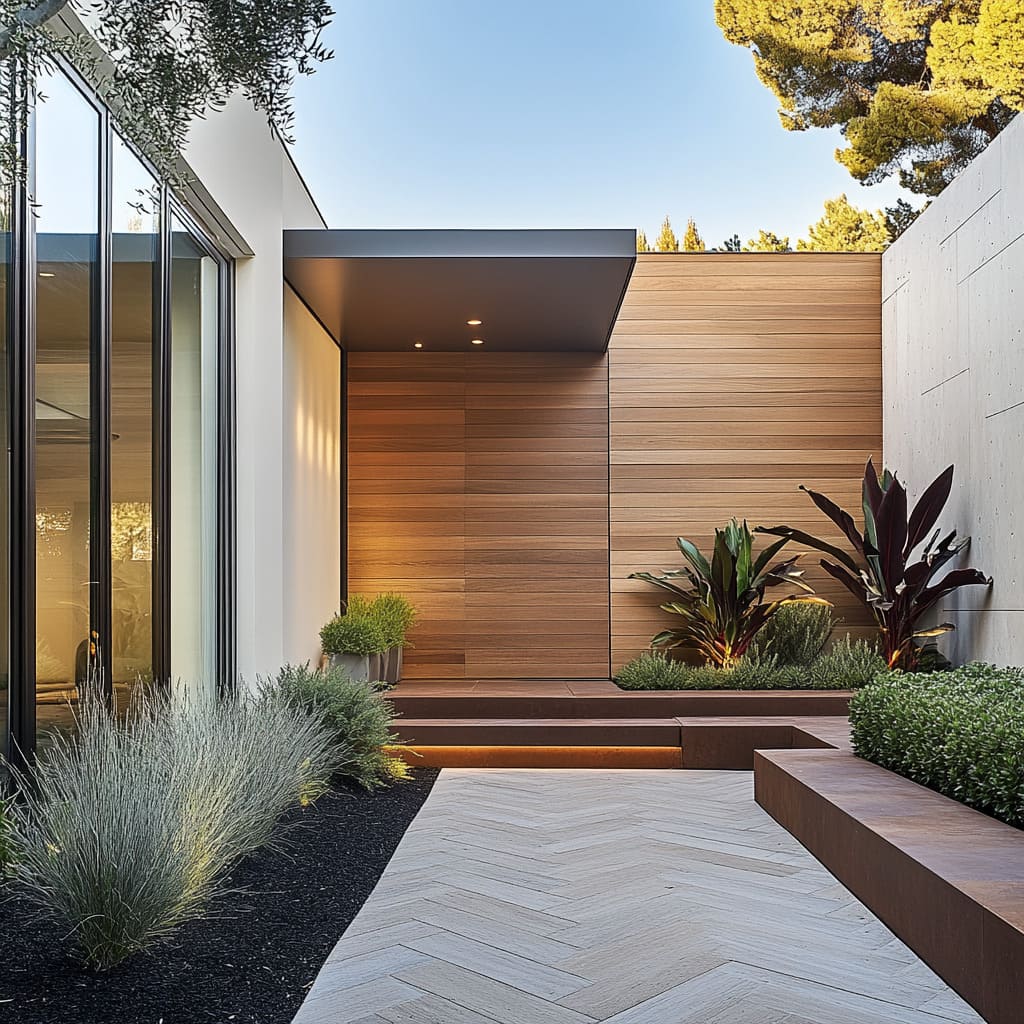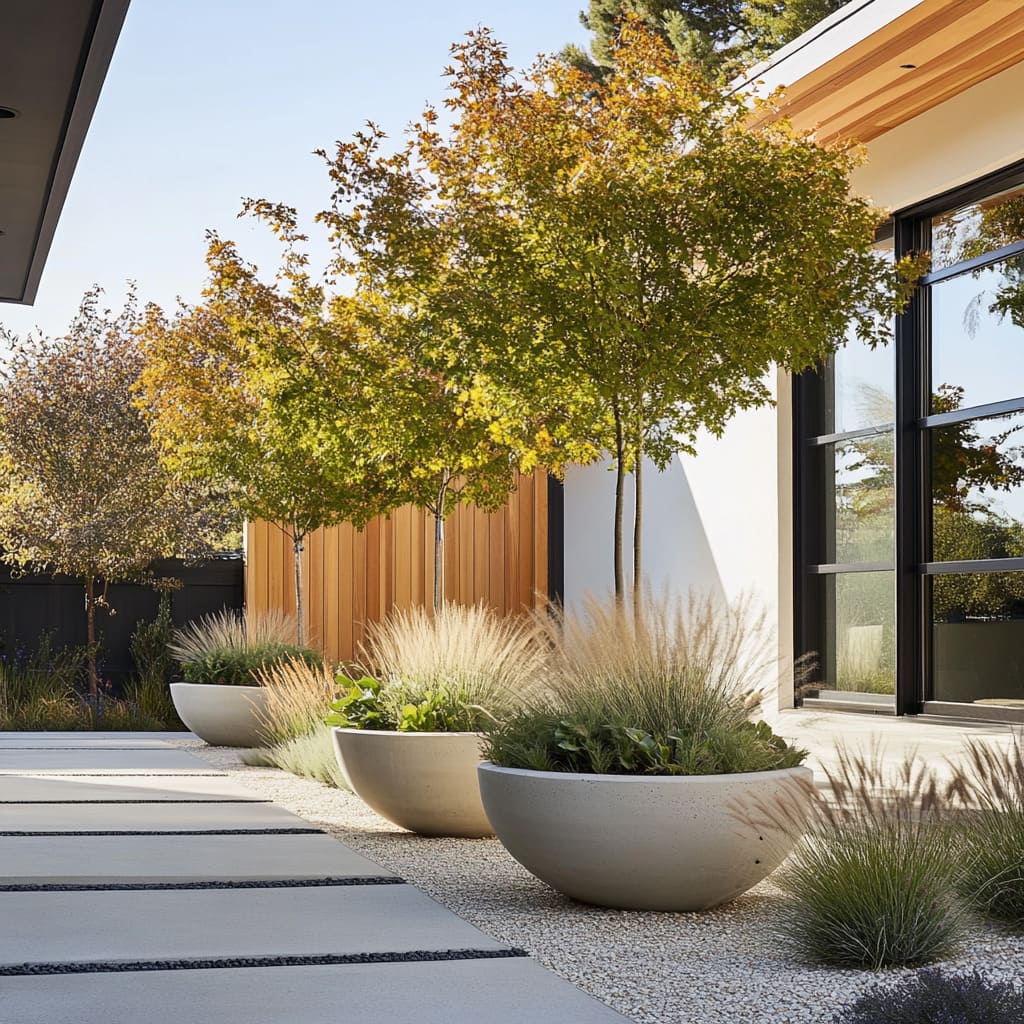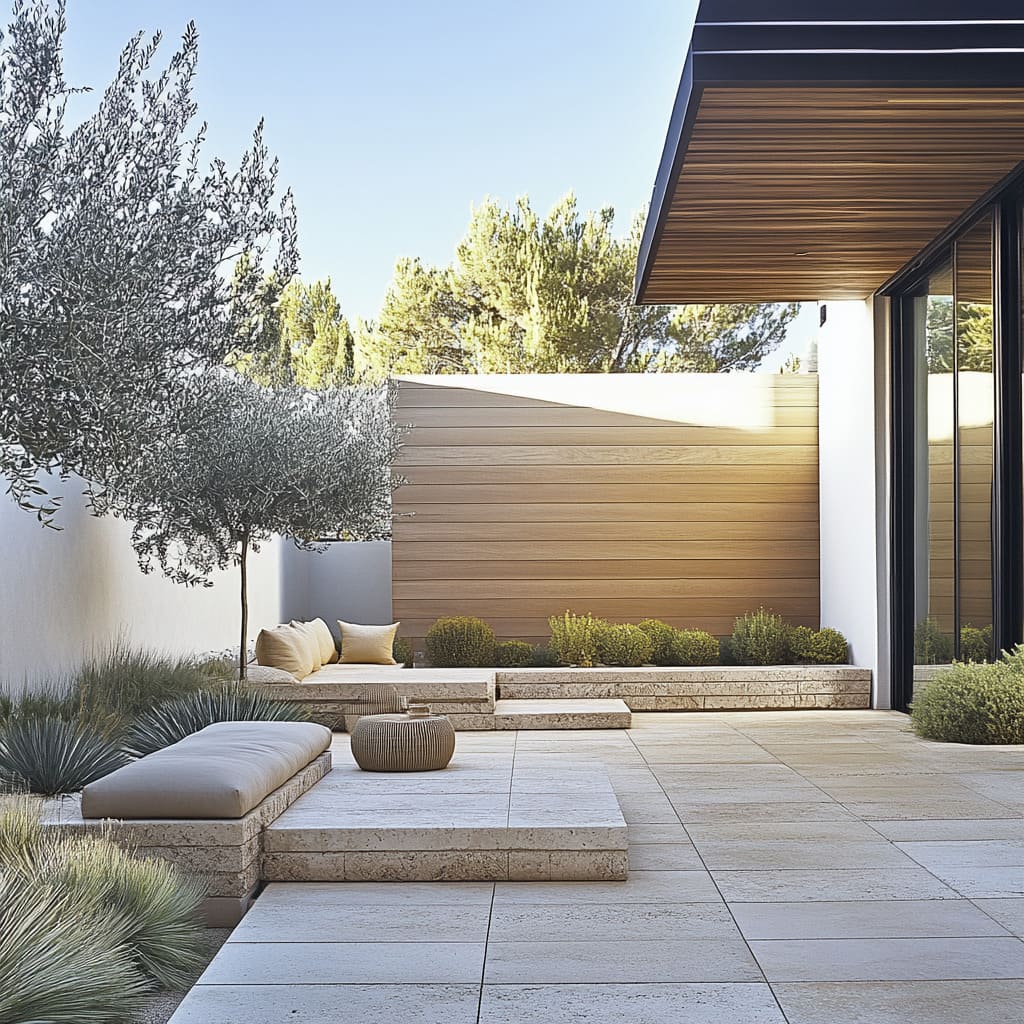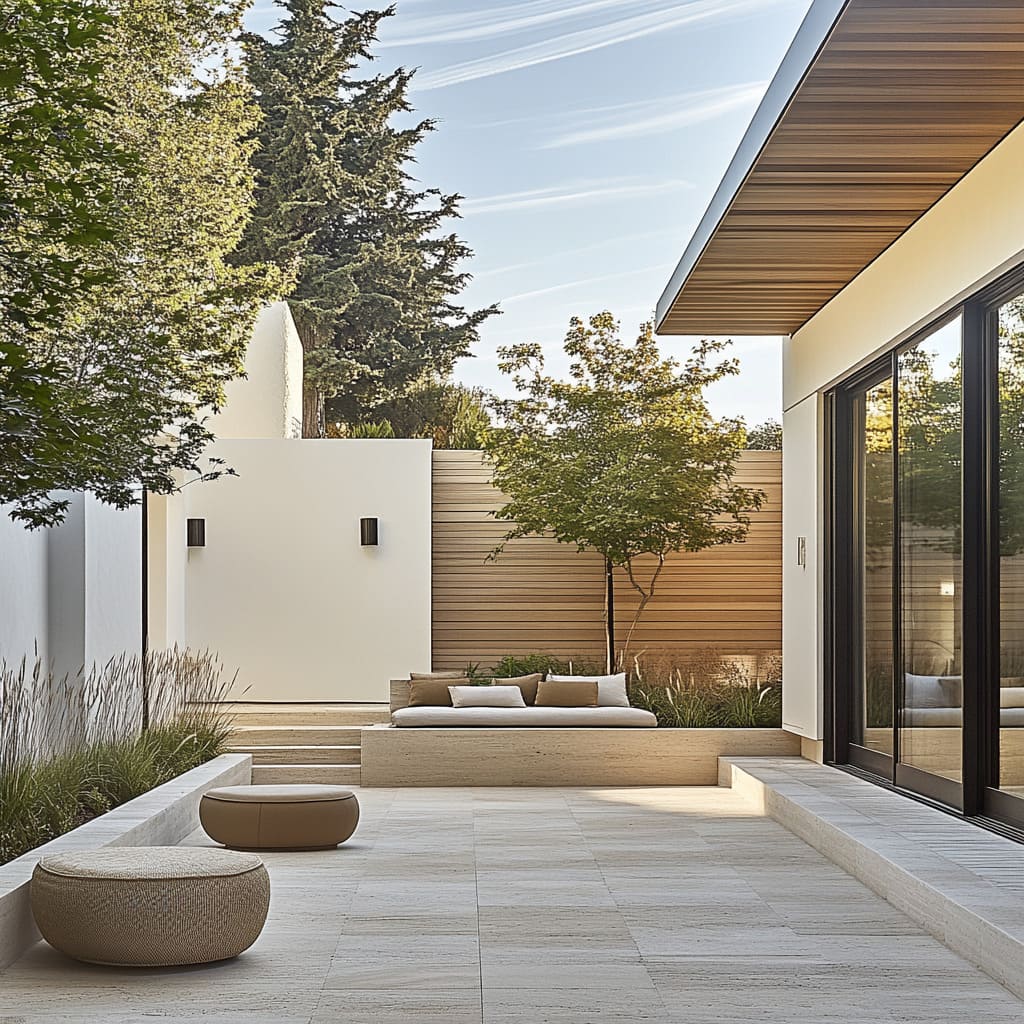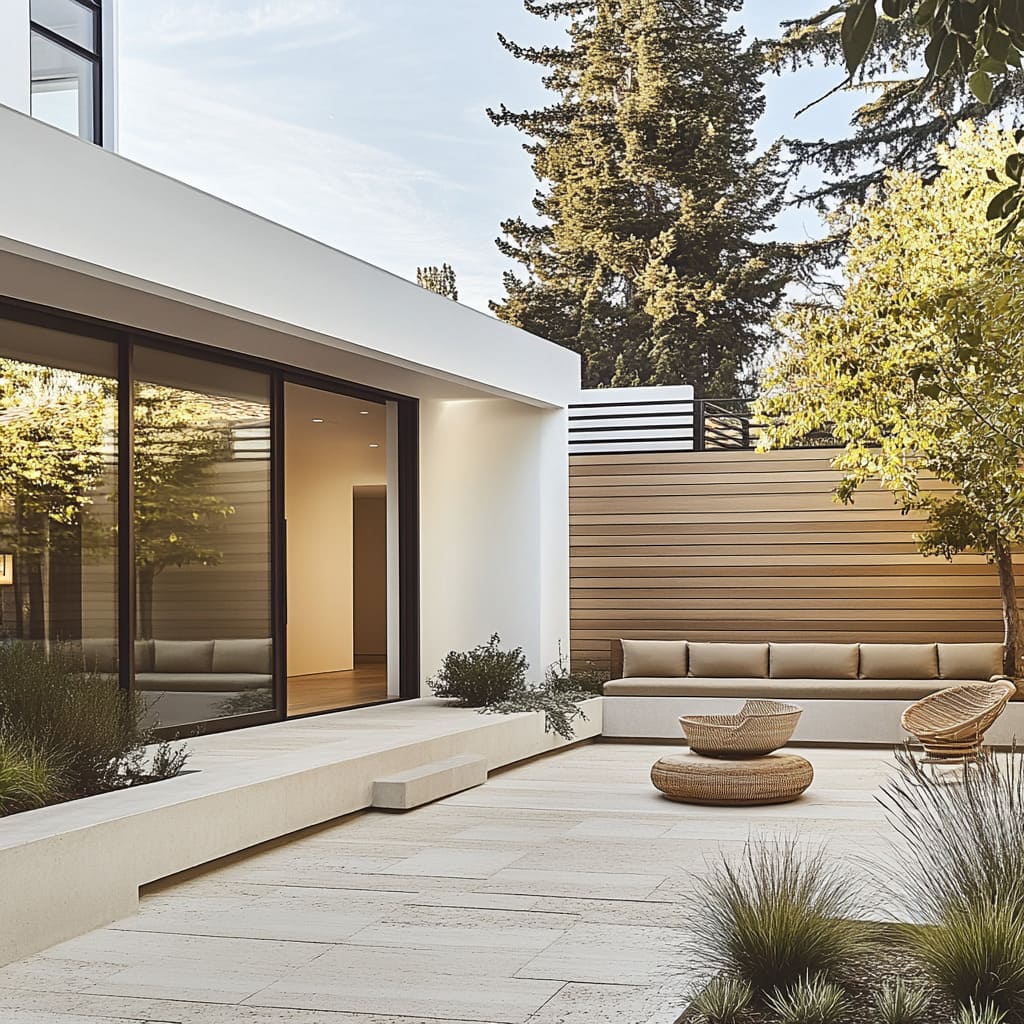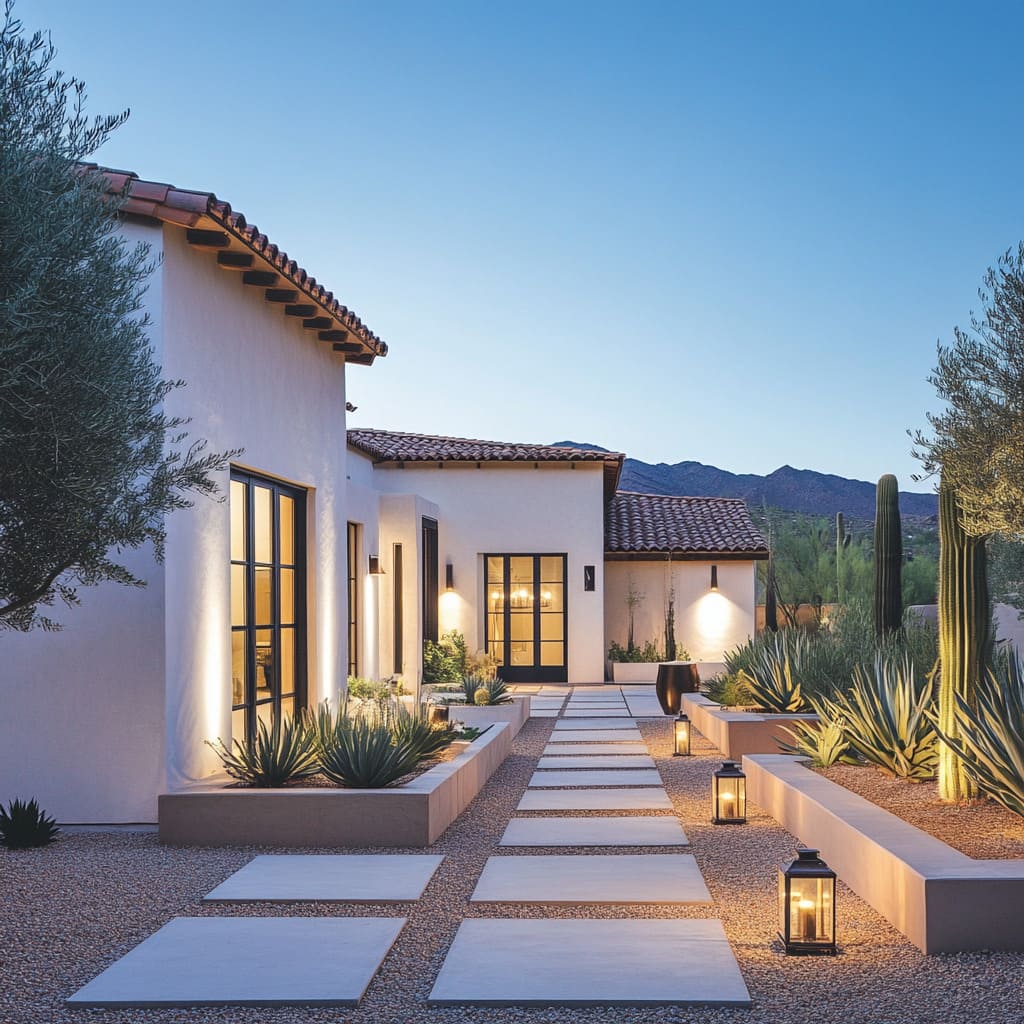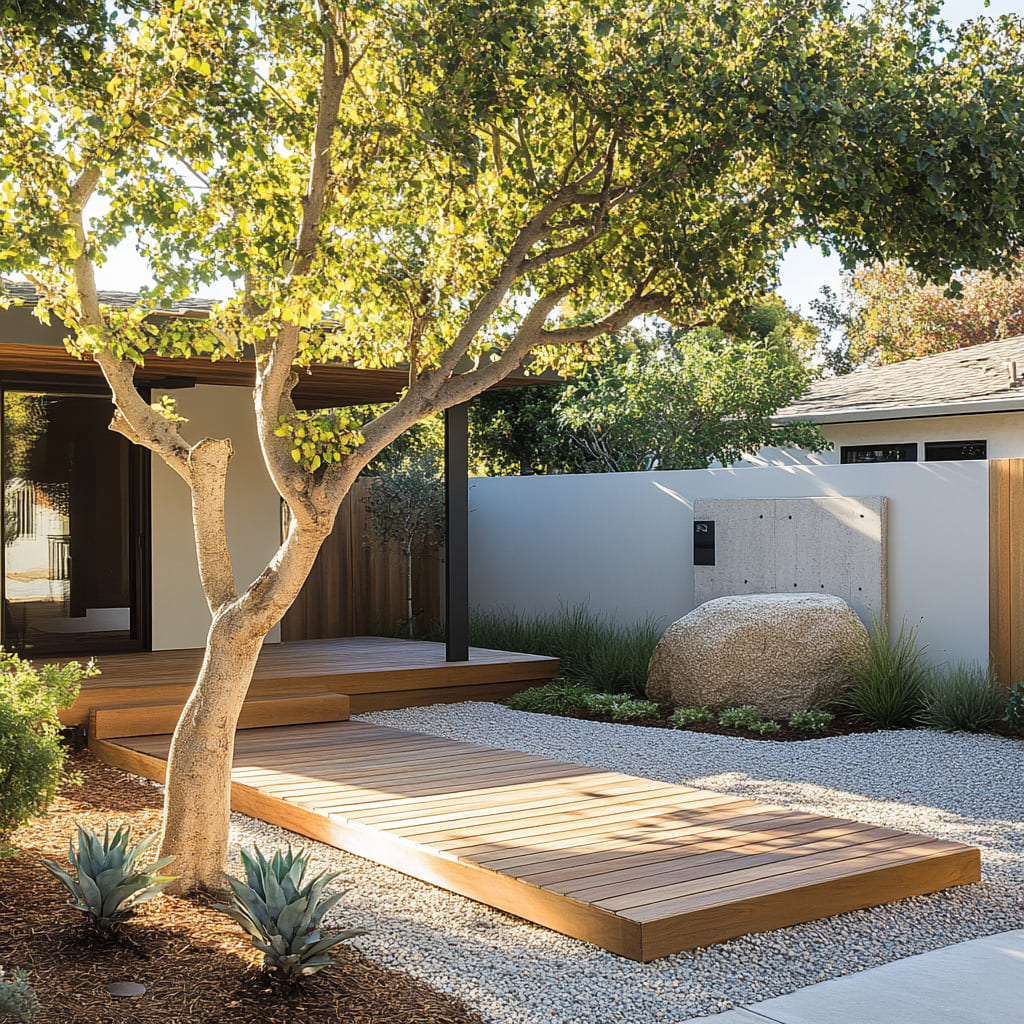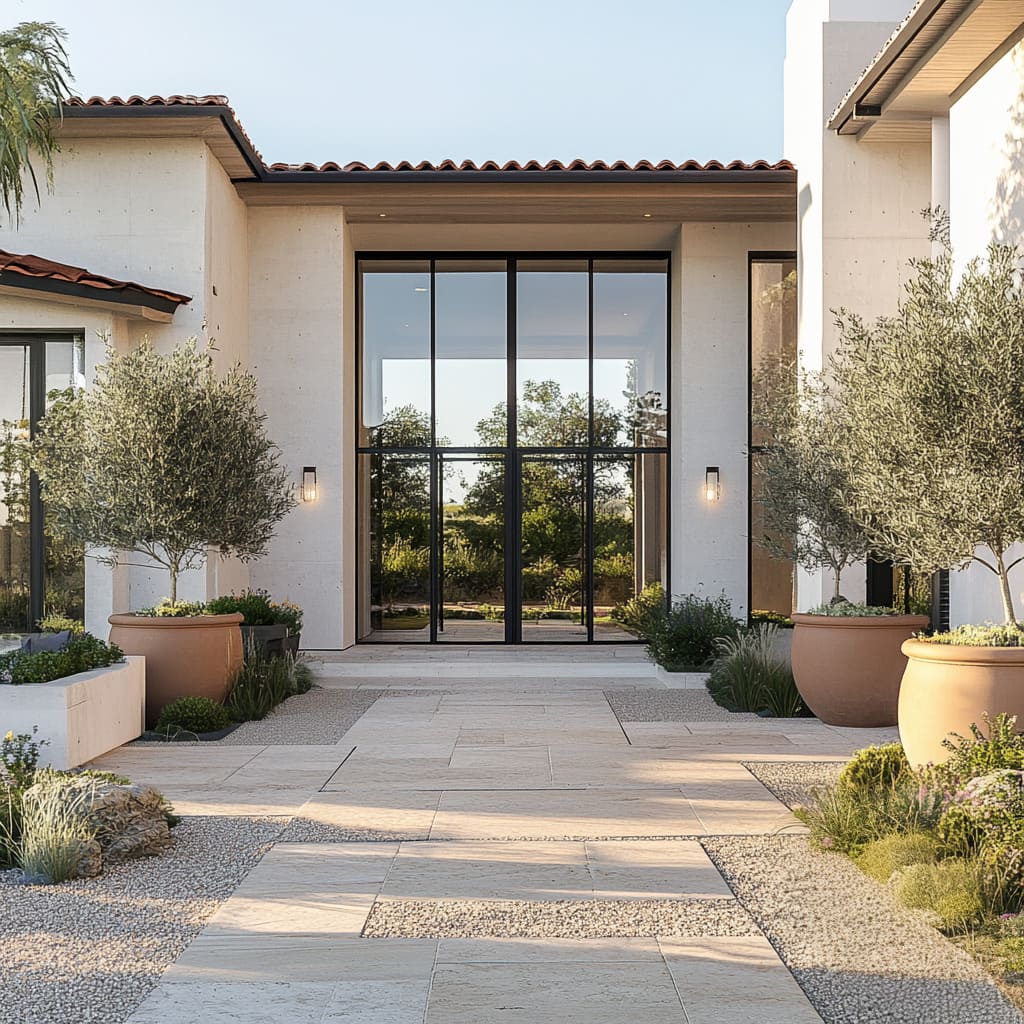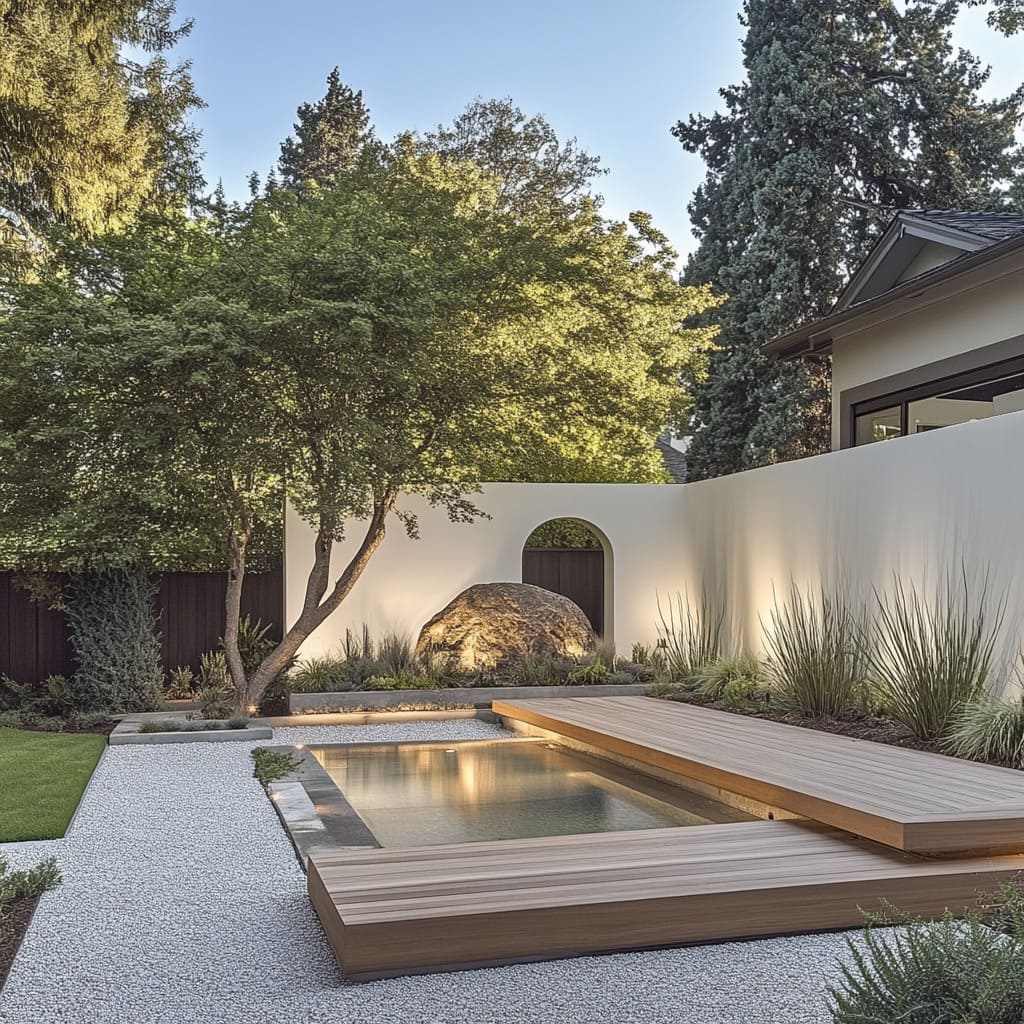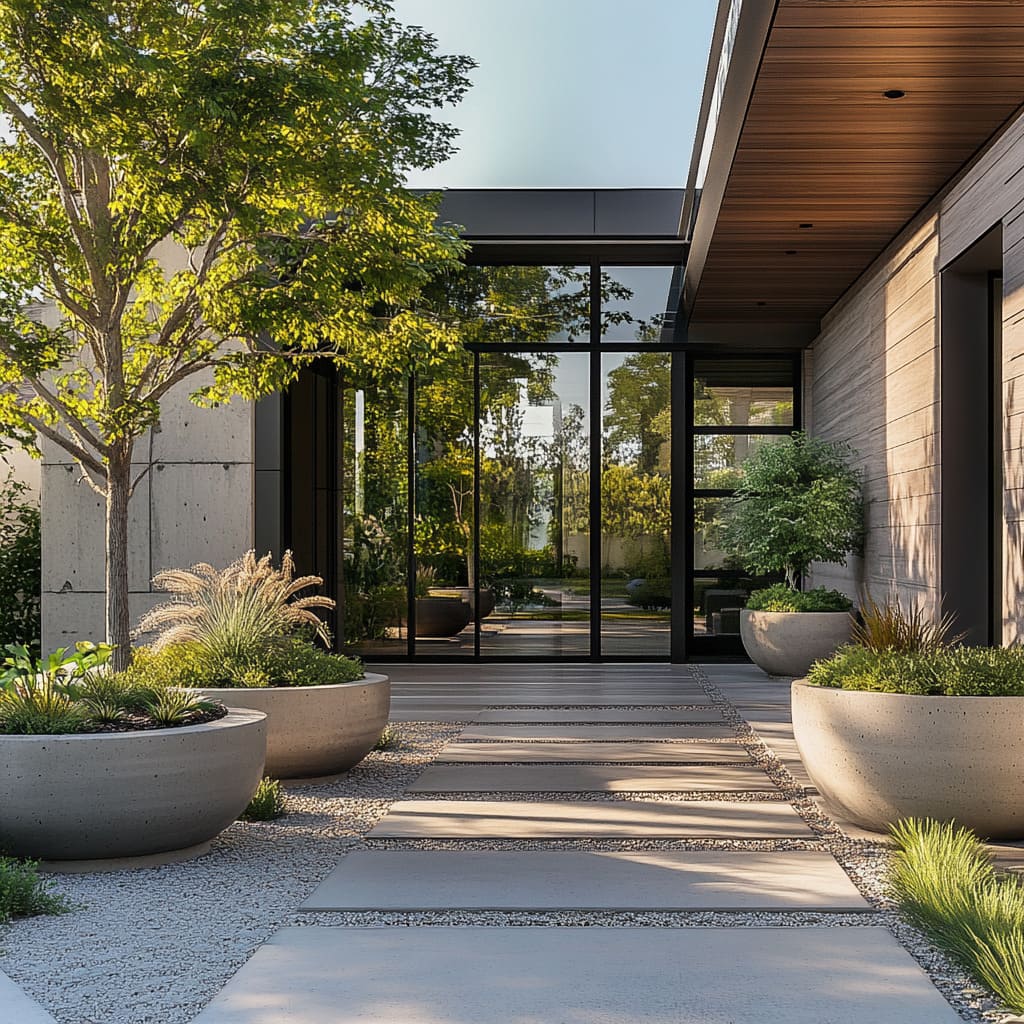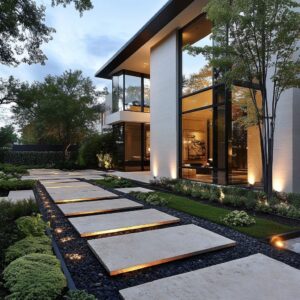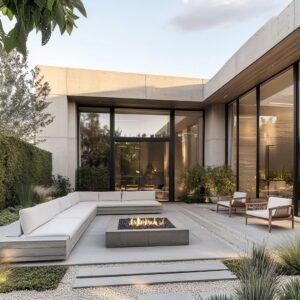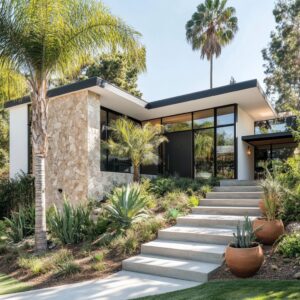In recent years, no-grass backyard ideas have taken center stage as homeowners look for innovative ways to create beautiful outdoor spaces that demand minimal upkeep. The shift toward no maintenance front yard landscaping has opened up a world of possibilities that combine style, sustainability, and practicality.
These modern designs prioritize clean lines, natural materials, and functional layouts while blending seamlessly with the home’s architecture. With lawns requiring constant care, the decision to forgo grass aligns with a growing preference for low-maintenance solutions without sacrificing visual appeal.
Gravel, stone tiles, and wooden elements create structured and timeless outdoor environments, while drought-resistant plants like agaves, succulents, and ornamental grasses introduce a sculptural, organic touch.
The overall style draws inspiration from contemporary minimalism, with a focus on achieving harmony between the hardscape and softscape. Yard designs often incorporate natural tones, contrasting textures, and creative lighting setups, resulting in a polished yet relaxed aesthetic.
Linear pathways, oversized planters, and multi-level decks redefine traditional yard spaces, transforming them into modern outdoor retreats ideal for both function and relaxation. This article highlights the trends, ideas, and design principles that make grass-free yards a stylish and low-maintenance choice.
By analyzing real examples of contemporary front and backyard designs, we explore the materials, solutions, and decorative ideas that define this approach, offering inspiration for anyone looking to rethink their outdoor space.
Dominant Principles of Modern Yard Designs
Modern yard designs revolve around carefully considered principles that combine aesthetics, practicality, and minimal upkeep. Whether it’s a stylish backyard retreat or a sleek front entryway, these spaces prioritize balance, simplicity, and cohesion with the home’s exterior.
Minimalism and Simplicity
Minimalism is the backbone of modern outdoor spaces, shaping everything from layouts to decorative choices. Clean lines and uncluttered arrangements take precedence, creating yards that feel intentional and organized.
Geometric pathways—whether in stone slabs or concrete—offer strong visual direction while maintaining a crisp, contemporary edge. Plant placement remains restrained, avoiding overgrown greenery in favor of small clusters of drought-resistant shrubs or trees.
A prime example is the use of singular, sculptural plants like agave or olive trees set in gravel beds, accentuating their bold forms. By leaving breathing space between materials and plants, yards achieve a refined look that avoids visual noise, enhancing the appeal of modern backyard ideas with no grass.
Low Maintenance
The rise in no-grass designs reflects a clear desire for convenience without compromising style. With homeowners increasingly aware of the time and resources required to maintain traditional lawns, gravel, decorative stone, and large pavers have become go-to solutions.
These materials are durable, timeless, and virtually maintenance-free, making them ideal for busy lifestyles. When greenery is introduced, it takes the form of drought-tolerant plants that thrive in various climates.
Choices such as cacti, ornamental grasses, succulents, and shrubs provide textural contrast while needing minimal care. Mulch or gravel further reduces the need for regular watering and mowing, supporting eco-friendly designs.
Balance Between Hardscape and Softscape
A successful modern yard strikes a delicate balance between hard materials and natural greenery. Hardscape elements such as stone tiles, wooden decking, or concrete form the structural foundation of the yard.
These surfaces dominate large portions of the layout, but the inclusion of plants and trees softens their appearance. For example, planters filled with lush greenery or clusters of grasses break up large expanses of stone, introducing life and movement to the design.
Thoughtful softscape placement—whether through linear garden beds, potted plants, or trees—ensures the yard feels inviting rather than stark. This balance also reinforces the connection between nature and structure, a key feature of contemporary yard design.
Integration with Architecture
Modern outdoor spaces aren’t standalone features—they’re seamless extensions of the house itself. Material selections, colors, and design elements are intentionally chosen to match or complement the home’s exterior.
Warm wood paneling seen on house facades often reappears in fencing, pergolas, or built-in seating, establishing a sense of unity. Similarly, neutral tones like beige, grey, or charcoal in stone pathways or walls blend effortlessly with contemporary homes.
This integration allows outdoor spaces to feel like a natural continuation of the home rather than an afterthought. For example, front yard landscaping ideas with rocks no grass often reflect the home’s clean lines and modern finishes, ensuring a cohesive look.
Large-format pavers, wooden accents, and subtle greenery mirror the sleek design principles seen indoors. By incorporating these dominant principles, modern yards achieve a balance of form and function.
They become practical, stylish spaces that enhance the overall property while reducing maintenance demands. The combination of minimalism, low upkeep solutions, softscape-hardscape harmony, and architectural integration delivers outdoor environments that feel both visually striking and effortlessly livable.
Materials and Finishes: Combinations and Patterns
The materials and finishes used in modern yards without grass are carefully selected for durability, aesthetics, and low maintenance. By focusing on natural textures and contemporary finishes, designers achieve functional spaces that feel visually striking and timeless.
These materials not only replace grass but also bring versatility and style, ensuring the yard serves as both a practical and artistic extension of the home.
Main Materials
Stone Tiles and Pavers
Large-format tiles made from materials like travertine, limestone, or polished concrete dominate modern yard designs. They form sleek, structured pathways, patios, and flooring that are resistant to weathering, require little upkeep, and maintain their appeal over time. In a low maintenance modern front yard landscaping, these pavers often anchor the layout, their muted earth tones blending seamlessly with the home’s exterior while delivering a modern edge. Straight-lined installations enhance geometric precision, a signature of contemporary outdoor spaces.
Gravel
Gravel provides a textural, low-cost alternative to lawns and is often laid in expansive sections or used as an accent around pathways. Its practical permeability allows for proper drainage while preventing puddles or overwatering—especially beneficial in drought-prone areas.
Designers frequently combine gravel with tiles or stepping stones to introduce contrast. For example, a pathway with evenly spaced stone slabs set within gravel enhances both function and design.
Whether fine, crushed gravel or larger river stones, the material offers flexibility to fit various yard styles while remaining maintenance-free.
Wood
Natural wood elements bring warmth and a sense of balance to modern hardscapes. Smooth wooden decking is often seen in no lawn backyard layouts, softening the appearance of stone and concrete.
Vertical wooden slat fences have emerged as a key trend, offering privacy without feeling bulky or closed-off. The linear nature of these fences contrasts beautifully with natural landscaping while complementing modern home exteriors.
Wood also appears in pergolas, built-in benches, and planter cladding, adding texture and organic richness.
Concrete
Concrete continues to be a versatile choice for both functional and decorative yard elements. Oversized planters, retaining walls, and seating blocks made from raw or polished concrete introduce sculptural elements that feel bold yet understated. This material works especially well in geometric forms, enhancing the clean lines associated with modern designs. Its ability to blend with wood, stone, and greenery ensures it fits seamlessly into the overall yard layout.
Natural Rocks
Strategically placed natural boulders act as visual anchors, adding weight and dimension to the yard design. These rocks often break up expanses of gravel or serve as standalone decorative pieces.
When paired with drought-resistant plants like agave or ornamental grasses, boulders help establish a more organic, textured feel that complements the surrounding hardscape.
Design Combinations
Stone Tiles + Gravel
A timeless combination, stone pathways set within gravel create an eye-catching contrast while ensuring functionality. The linear layout of the tiles provides structure, while the gravel adds an organic, relaxed finish. This pairing works beautifully in both expansive backyards and compact front yards, emphasizing clean lines while avoiding the maintenance of traditional lawns.
Wood + Concrete
Blending organic and industrial elements, wood and concrete form a dynamic contrast that defines modern yard aesthetics. Wooden decks, fences, or seating areas paired with concrete planters or pathways bring balance and a contemporary touch.
This mix grounds the design, with the wood’s warmth softening the starkness of concrete.
Smooth Walls + Textured Fences
Smooth, white plaster walls often serve as a canvas for more textured elements, like wooden slat fences or natural stone surfaces. The juxtaposition of these finishes creates visual interest without clutter. In modern yards, the smoothness of plaster or concrete walls reflects light beautifully, enhancing the overall ambiance while acting as a neutral backdrop for plants and decor.
Round Planters + Rectangular Pathways
The contrast between curved and straight-lined forms adds an intentional sense of balance to the design. Oversized concrete or ceramic planters with rounded edges break up rigid pathways and patios, softening the visual flow while introducing dimension.
This combination not only adds style but also makes the layout feel more dynamic and layered.
Patterns and Insights
These material combinations are more than purely aesthetic—they function together to balance design principles like contrast, texture, and spatial flow. Patterns like embedded pathways, gravel bases, and mixed finishes reinforce the clean yet organic look central to modern landscaping.
Designers emphasize simplicity while carefully curating layers of material to avoid visual monotony. The popularity of linear layouts and bold materials stems from the need for structure and harmony.
Where stone provides precision, wood introduces warmth, and gravel offers texture, the interplay of these materials results in a cohesive, low-maintenance yard that feels complete without grass. By focusing on simplicity, durability, and aesthetic appeal, modern yards replace traditional lawns with innovative combinations that require minimal upkeep while remaining functional and stylish.
Styles and Aesthetic Trends
Modern yard designs reflect the shift toward clean, functional aesthetics that align with contemporary architecture. The styles emerging today are deeply influenced by minimalism, sustainability, and a desire to blend natural beauty with practical solutions.
Whether you are transforming a low maintenance backyard or creating a polished front space, these design approaches prioritize both form and function.
Japandi and Minimalist Influence
Japandi, a mix of Japanese and Scandinavian design principles, has become a leading inspiration for modern yard spaces. The emphasis on clean lines, neutral palettes, and functional simplicity defines these outdoor areas.
Wooden finishes, whether in slatted fences or built-in seating, provide subtle warmth, balancing the minimalistic stone and concrete surfaces. Low-profile furniture with natural tones, like beige or light grey, seamlessly complements the muted landscaping.
The planting is restrained—think ornamental grasses, single trees, or clusters of succulents strategically placed for visual clarity. Every element feels intentional, with space being treated as a critical part of the design itself.
Minimalist outdoor spaces highlight less is more. Yards avoid clutter while focusing on textures and subtle contrasts.
Smooth concrete pathways against gravel or lightly brushed stone tiles create striking linearity. Planters are often oversized and curved, adding softness to the otherwise structured geometry.
The result is a calming, cohesive environment where every feature contributes to visual balance. This approach works exceptionally well for front yard designs without grass, giving homes a polished, contemporary edge.
Desert-Inspired Landscaping
The increasing popularity of drought-resistant landscaping has led to the rise of desert-modern designs. Inspired by arid regions, these yards favor native, low-water plants such as agaves, yuccas, succulents, and ornamental grasses.
Instead of traditional lawns, gravel, sand, or crushed stone forms the base, reducing maintenance while promoting sustainability. The muted tones of the gravel—often beige, light grey, or tan—provide a natural canvas for bold greenery to stand out.
Cacti and boulders become sculptural elements in desert-inspired landscapes, breaking up the clean lines of pathways or patios. Designers often use spacing as a creative tool, allowing gaps in planting and hardscaping to emphasize minimalism.
Warm wooden finishes, concrete seating, and stone tiles tie the design together, creating harmony between manmade elements and the natural environment. This style works beautifully in regions with drier climates, showcasing how functionality can meet striking aesthetics.
Mid-Century Modern Elements
Mid-century modern trends are returning to outdoor design, particularly in yards where open spaces and geometric precision take center stage. Linear pathways, often made of large rectangular pavers, lead to patios, fire pits, or open courtyards.
This structured layout reflects the architectural style of the mid-20th century, where simplicity and connection to nature were key themes. Large glass windows or sliding doors blur the line between indoors and outdoors, transforming backyards into natural extensions of the home.
Courtyards surrounded by smooth walls or privacy screens provide intimate, usable spaces for seating and lounging. To balance the structured layout, plant choices tend to be minimal, with a focus on architectural plants like agaves or palm varieties.
This combination of clean lines and carefully curated greenery creates a backyard that feels both nostalgic and modern.
Natural and Industrial Fusion
One of the defining features of modern yards is the balance between raw, industrial materials and natural elements. Stone tiles, polished concrete, and raw steel planters bring a rugged, industrial edge, while wood and greenery soften the overall appearance.
This interplay of hard and soft materials grounds the design, preventing it from feeling too stark or cold. Planters made of concrete or corten steel are particularly popular, often filled with ornamental grasses, shrubs, or succulents.
They act as sculptural focal points while maintaining practical uses for plants. Wooden decking or fences offset the industrial materials, ensuring a balance of tones and textures.
Gravel pathways add a natural texture underfoot, while large boulders or trees break up the symmetry, introducing organic contrast. This combination highlights how modern yards can feel both contemporary and deeply connected to the environment.
Modern yard designs thrive on simplicity, intentional material choices, and the seamless blending of styles. Whether inspired by Japandi minimalism, desert aesthetics, or mid-century architecture, these spaces prioritize low maintenance without compromising on beauty.
By balancing raw and refined materials, creating visual contrast, and incorporating functional greenery, today’s outdoor spaces have redefined what it means to design with purpose.
Functional and Decorative Solutions
Modern no-grass yards seamlessly combine practical features with stylish, eye-catching design. By blending form and function, these outdoor spaces achieve a balance that prioritizes usability while maintaining a visually sophisticated look.
Creative layouts, versatile seating, and decorative focal points work together to ensure these spaces are as practical as they are beautiful.
Pathways and Layouts
One of the most striking features of no-grass designs is their use of floating pathways. Rectangular stone pavers, often made of travertine, concrete, or limestone, “float” over a gravel or sand base, creating a clean, linear structure while maintaining visual lightness.
This layout not only guides movement throughout the space but also lends a modern, refined look. The gravel beneath the pavers offers contrast and serves as a functional, low-maintenance ground cover that complements the stone’s clean edges.
Multi-level decks are another clever solution for defining different zones within a yard. Wooden platforms, concrete tiers, or a combination of both provide clear separation for seating, planters, and pathways.
These levels add dimension to the landscape, creating interest while optimizing smaller spaces. Decks constructed from natural wood soften the look, while concrete tiers bring a modern industrial edge.
Together, these materials emphasize versatility and structure within the overall layout. Framed spaces, often created with raised planters or retaining walls, add a clear sense of organization to the yard.
These structural elements delineate areas for plants, seating, or decorative features, offering both function and visual appeal. Whether crafted from smooth concrete, natural stone, or raw steel, these walls frame pathways and seating zones, enhancing the design’s clarity and purpose.
Raised planters are particularly effective in smaller yards, offering depth and variety without overwhelming the space.
Planters and Seating
Oversized concrete planters play a key role in modern concrete landscape ideas, acting as both functional and sculptural components. These planters anchor the design by housing drought-resistant greenery such as succulents, ornamental grasses, or small trees.
Their sheer size allows them to stand out as focal points, while their neutral tone complements other materials like wood or gravel. Round planters, in particular, soften the yard’s sharper geometric lines, adding visual balance to otherwise rigid layouts.
Integrated seating takes the practicality of these designs to the next level. Built-in benches made of concrete, stone, or wood blend seamlessly with their surroundings, providing functional seating while maintaining clean lines.
These benches are often positioned alongside raised planters or retaining walls, serving a dual purpose as both decor and utility. This solution keeps the yard visually uncluttered while offering a designated place for relaxation or gatherings.
Organic planter shapes are becoming a signature feature in modern yards. While much of the design relies on geometric patterns, curved planters introduce a softer, more fluid element.
These unusual shapes contrast with the linearity of pathways or decks, creating a sense of harmony through variation. By integrating greenery into these shapes, designers strike a balance between organic and structured aesthetics.
Decor and Accents
Strategic tree placement is a hallmark of modern no-grass yards. Whether it’s a single tree acting as a sculptural anchor or a pair of trees framing the yard, their placement adds scale and symmetry to the overall design.
Olive trees, maples, or Japanese varieties are often used for their clean lines and low-maintenance qualities. These trees create subtle focal points without overwhelming the space, proving that even larger elements can work in minimalist landscapes.
Natural rocks, such as large boulders, are a timeless decorative solution in no-grass yard ideas. Placed thoughtfully alongside pathways, gravel sections, or planters, these rocks act as organic focal points, bringing texture and grounding the design.
Their raw, unpolished surfaces contrast beautifully with smooth tiles or concrete, making them an essential component in adding visual variety. Finally, woven and textural accents complete the look by adding comfort and tactile interest.
Wicker ottomans, natural fiber cushions, or decorative pebbles offer a layer of coziness that balances the yard’s hardscaping. These textural elements are particularly effective in seating areas, where soft materials invite relaxation while maintaining the modern aesthetic.
Small details like pebbles in planter beds or cushions on benches subtly elevate the design’s overall warmth and livability. By combining functional pathways, versatile planters, integrated seating, and thoughtful accents, modern no-grass yards achieve the perfect balance of style and usability.
Features like multi-level decks, oversized planters, and natural rocks ensure that every part of the design feels intentional. Whether you’re transforming a large outdoor space or a compact yard, these solutions demonstrate how no-grass designs can be practical, stunning, and effortlessly low maintenance.
Lighting Strategies
Lighting is an essential aspect of modern yard design, serving as both a functional necessity and a design tool that enhances the space’s atmosphere. Carefully planned lighting not only makes pathways and seating areas usable after dark but also transforms the yard into a visually stunning scene.
In no-grass yards, lighting brings warmth and depth to spaces that rely on hard materials like stone, wood, and concrete, offering a softer contrast while accentuating the overall design.
Ground-Level Lights
Ground-level lights are a subtle yet impactful choice for illuminating pathways and surfaces. Recessed or low-profile fixtures installed along stone or concrete walkways guide movement while creating soft, inviting illumination.
When placed near gravel sections or natural rocks, these lights highlight the texture and contours of the ground, adding visual interest to an otherwise minimalist layout. In spaces featuring smooth surfaces like travertine tiles or polished concrete, ground-level lights add dimension by creating gentle shadows and emphasizing clean lines.
These fixtures are particularly effective in smaller areas, as they offer illumination without cluttering the design with visible hardware.
Tree Uplighting
Tree uplighting is a favorite technique in modern yard design, creating bold yet sophisticated nighttime focal points. Placing lights beneath sculptural trees like olive, maple, or ornamental varieties draws attention to their unique forms, transforming them into glowing silhouettes.
This approach works particularly well in no-grass yard ideas, where trees play a more prominent decorative role due to the absence of greenery. The upward glow enhances the architectural qualities of trees—their branches, leaves, and shadows—while grounding the yard in a sense of organic beauty.
For yards with smaller trees, focused uplighting can create the illusion of height and grandeur, adding balance to areas with flat pathways or low planters.
Wall Sconces and Lanterns
Wall sconces and lanterns bring character and warmth to spaces with smooth stucco, plaster, or white concrete walls. These fixtures are often chosen in warm, golden tones to create contrast against cool-colored materials, softening the overall ambiance.
In low-maintenance yards that prioritize simplicity, these lights double as decor, providing structure and personality without unnecessary ornamentation. Placement is key—sconces are typically aligned along pathways or seating areas, while lantern-style fixtures flank entryways or focal walls.
At night, they emphasize the clean geometry of modern yards while casting gentle glows that complement materials like wood decking, stone steps, or vertical slat fences.
Soft Indirect Glow
For an understated and contemporary effect, LED strip lighting has become a go-to solution in modern landscapes. Placed beneath benches, steps, or deck edges, LED strips offer a soft, indirect glow that outlines key architectural features.
This technique works particularly well in concrete landscape ideas where sharp lines dominate the design. By illuminating edges, the lighting creates depth and defines the structure without overpowering the space.
The clean, subtle effect of LED strips also harmonizes with other lighting choices like uplights or wall-mounted fixtures, contributing to a cohesive nighttime aesthetic. Whether integrated under wooden decking or concrete steps, indirect lighting ensures the space feels modern, functional, and inviting.
By combining ground-level fixtures, uplighting for trees, wall-mounted lanterns, and indirect LED strips, modern yard designs achieve a perfect balance of form and function. Lighting not only makes pathways, seating, and decorative elements more usable but also transforms hardscapes into works of art after dark.
Each strategy contributes to the overall aesthetic, enhancing textures, defining architectural lines, and creating focal points. With thoughtful placement, lighting brings warmth and dimension to even the most minimalist no-grass spaces.
Common Planting Choices
Creating a no grass landscaping ideas yard relies heavily on thoughtful plant selection. These spaces prioritize sustainable greenery that thrives in a variety of climates with minimal upkeep.
With low-water options taking center stage, plants are carefully chosen for their visual structure, texture, and ability to complement modern hardscapes of stone, concrete, and wood.
Succulents and Cacti
Succulents and cacti are a staple in low maintenance backyard designs for their striking forms and resilience. Plants such as agaves, aloes, and barrel cacti provide a sculptural quality that naturally enhances modern layouts.
Agaves, with their sharp, symmetrical leaves, make perfect focal points when planted in oversized planters or among gravel and rocks. Barrel cacti, on the other hand, add rounded shapes that soften rigid pathways or concrete platforms.
Aloes introduce height and subtle color variations with their elongated leaves and occasional flowering spikes. These plants are versatile, thriving in raised planters, layered beds, or as standalone pieces, creating an impactful design while requiring very little water or care.
Ornamental Grasses
Ornamental grasses are key to achieving texture and movement in low-maintenance, no-grass yards. Options like fountain grass, feather reed grass, and blue fescue bring visual softness and add an organic flow to otherwise structured spaces.
Fountain grass works beautifully alongside smooth concrete pavers or gravel pathways, its feathery plumes gently swaying with the breeze. Feather reed grass, with its vertical form, creates visual height and serves as an excellent backdrop for low-sitting succulents and boulders.
Meanwhile, the bluish tones of blue fescue provide a refreshing color contrast to warmer wood tones or neutral stone surfaces. These grasses not only thrive in dry conditions but also require minimal pruning, making them an excellent choice for effortless beauty.
Mediterranean Trees
Mediterranean trees such as olive trees and maples are popular additions to modern no-grass designs. Olive trees, with their silvery leaves and sculptural trunks, lend a timeless elegance to contemporary yards.
Their ability to grow in sandy, dry soil makes them ideal for no-maintenance spaces, often planted in oversized concrete or terracotta pots for added visual impact. When positioned as focal points, olive trees can anchor the yard and provide much-needed shade in seating areas.
Maples, particularly Japanese varieties, bring a delicate architectural quality, with their fine, layered branches adding visual interest and softening sharp design lines. These trees complement both gravel-covered surfaces and stone pathways while thriving in water-efficient landscapes.
By combining sculptural succulents, flowing grasses, and timeless Mediterranean trees, homeowners can craft a visually appealing yard without the need for high-maintenance greenery. The careful placement of plants balances rigid pathways, oversized planters, and minimalistic hardscapes, adding softness and texture to the overall design.
This thoughtful blend of structure and greenery ensures that no-grass yards remain not only practical but also strikingly beautiful.
Designer Insights and Ideas
Modern no-grass yard designs aren’t just about aesthetics—they embody thoughtful principles that balance practicality, visual appeal, and sustainability. By analyzing recurring design elements, patterns, and unique approaches, a few clear insights emerge that can help transform a simple yard into an inspiring outdoor haven.
Integration of Multi-Sensory Elements
A well-designed yard appeals to more than just the eye. Modern outdoor spaces successfully combine visual simplicity with rich, natural textures, soft lighting, and an organic layout that invites movement and connection.
Smooth travertine or limestone tiles contrast beautifully with rough gravel, creating a tactile journey through the space. When coupled with strategic lighting, such as uplights under trees or ground-level fixtures along pathways, the yard transitions seamlessly from day to night.
For seating zones, adding elements like natural wood benches with soft fabrics or woven ottomans introduces warmth and comfort, enhancing the sensory experience. These touches make a garden design with no lawn more inviting while ensuring it feels alive and connected to nature.
Hierarchy of Spaces
Modern no-grass yards often rely on spatial organization to bring clarity and function to outdoor areas. Raised planters, tiered decks, and multi-level platforms play a key role in defining zones.
For example, seating spaces may be slightly elevated using concrete or wooden platforms, while pathways float over gravel to distinguish movement areas from resting spots. This hierarchy provides depth and character, even in small spaces, making the design appear larger and more dynamic.
Planters placed at different heights also add variety, ensuring vertical interest without crowding the layout. In larger yards, pathways with staggered pavers or embedded stone tiles guide visitors naturally through different zones, creating intentional flow.
Intentional Asymmetry
While modern yards lean toward clean lines and structured layouts, intentional asymmetry brings an organic, dynamic quality that prevents the space from feeling too rigid. Unevenly placed planters, irregularly spaced trees, or curved organic shapes alongside sharp pathways soften the overall design.
Large boulders are often positioned asymmetrically near pathways or seating areas, adding a naturalistic, unplanned look. This mix of structure and slight irregularity creates a more relaxed and visually interesting atmosphere, striking the right balance between formality and informality.
Emphasis on Verticality
Flat, open yards can sometimes feel underwhelming without grass. Modern designers combat this by introducing height through various elements.
Vertical wooden fences, tall concrete planters, and well-placed trees contribute vertical lines that draw the eye upward, enhancing the overall dimension of the yard. Slimline trees like olive trees or ornamental maples are particularly effective in adding vertical layers without overwhelming compact spaces.
In some designs, pergolas or outdoor structures are incorporated to add architectural height and provide shaded lounging areas. These strategies ensure that the yard feels dynamic and visually balanced while remaining clean and low-maintenance.
Tactile Contrast
One of the standout characteristics of no-grass yards is the thoughtful use of materials to create contrast. Pairing rough gravel with smooth stone tiles or raw concrete introduces diversity in texture, making the design more engaging.
Wooden accents, such as benches or fences, soften the hardness of concrete pathways and planters, while woven textures in seating add an additional layer of tactile comfort. This blend of rough and smooth, warm and cool materials prevents the space from feeling sterile or monotonous.
For example, a concrete yard idea with integrated wooden seating and soft ornamental grasses achieves a perfect mix of industrial edge and organic softness.
Sustainability Focus
Sustainability is at the core of no-grass yard designs, offering an eco-conscious approach to landscaping. By eliminating traditional grass, these yards significantly reduce water consumption while still delivering lush and visually appealing results.
Low-maintenance plants like succulents, cacti, and ornamental grasses thrive in minimal water conditions, aligning beautifully with sustainable design principles. Materials such as stone, gravel, and concrete not only last for years but also require little upkeep, further reducing environmental impact.
Designers also embrace permeable surfaces, such as gravel or sand, which improve drainage while maintaining the yard’s clean aesthetic. These insights reveal that the best no-grass yards are not only visually stunning but also carefully curated to maximize function, texture, and sustainability.
The combination of spatial organization, vertical elements, and sensory contrasts transforms outdoor spaces into practical, eco-friendly extensions of the home. Whether through tactile material choices or creative asymmetry, designers ensure that each yard feels unique, alive, and perfectly suited to modern living.
Conclusion
The common and specific features discussed in this article reveal a thoughtful approach to creating stunning, functional, and low-maintenance outdoor spaces. Modern no-grass yards prioritize clean design, sustainable materials, and innovative use of space to blend form with function.
Whether through stone pathways floating over gravel or the integration of raised planters and built-in seating, these yards prove that simplicity does not sacrifice visual appeal. The careful selection of materials like wood, concrete, and natural stone creates an intentional balance of textures, where rugged surfaces complement smooth finishes.
Combined with soft lighting strategies that highlight plants, pathways, and architectural details, the yard transforms into a cohesive and inviting outdoor retreat. These designs are not only visually striking but also work seamlessly with contemporary homes, offering timeless appeal and year-round usability.
Low-water plants such as succulents, ornamental grasses, and Mediterranean trees thrive in no-grass spaces, contributing to sustainability while maintaining structure and greenery. Designers embrace thoughtful planting, ensuring that foliage is sculptural, purposeful, and harmonious with the overall layout.
This results in a seamless blend of practicality and style, where each element—from the materials to the lighting—enhances both function and beauty. For homeowners seeking low maintenance yard ideas, these no-grass designs deliver the perfect solution.
By balancing minimalism with natural warmth, they provide a modern alternative to traditional lawns, prioritizing water conservation, ease of care, and a polished aesthetic. Ultimately, these yards prove that thoughtful planning and intentional design can transform any outdoor space into a statement that is as practical as it is stunning.
